JInternal
Image j 基本操作
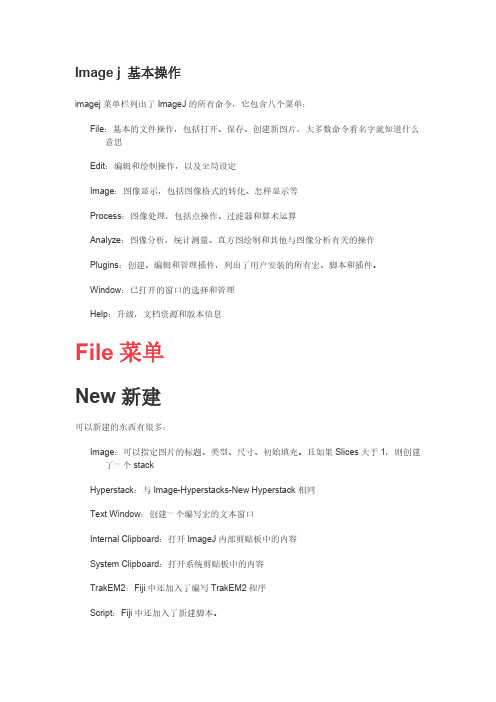
Image j 基本操作imagej菜单栏列出了ImageJ的所有命令,它包含八个菜单:File:基本的文件操作,包括打开、保存、创建新图片,大多数命令看名字就知道什么意思Edit:编辑和绘制操作,以及全局设定Image:图像显示,包括图像格式的转化、怎样显示等Process:图像处理,包括点操作、过滤器和算术运算Analyze:图像分析,统计测量、直方图绘制和其他与图像分析有关的操作Plugins:创建、编辑和管理插件,列出了用户安装的所有宏、脚本和插件。
Window:已打开的窗口的选择和管理Help:升级,文档资源和版本信息File菜单New新建可以新建的东西有很多:Image:可以指定图片的标题、类型、尺寸、初始填充。
且如果Slices大于1,则创建了一个stackHyperstack:与Image-Hyperstacks-New Hyperstack相同Text Window:创建一个编写宏的文本窗口Internal Clipboard:打开ImageJ内部剪贴板中的内容System Clipboard:打开系统剪贴板中的内容TrakEM2:Fiji中还加入了编写TrakEM2程序Script:Fiji中还加入了新建脚本。
Open打开可以打开的东西也有很多:常见图片,后缀有TIFF、GIF、JPEG、DICOM、BMP、PGM和FITS格式。
也可以通过插件打开额外的后缀的图片ImageJ和NIH的图片查询表,后缀是.lut以制表符分割的表格,后缀是.xls和.csv选区,后缀是.roi和.zip文本文件,后缀是.txt、.ijm、.js和.java其他Open Next打开下一个关闭当前图片,打开目录中的下一个图片(如果有的话)。
按住Alt打开目录中的前一个图片(如果有的话)。
Open Samples打开样例打开ImageJ服务器上的样例图片,可以用来测试宏、脚本、插件等。
Open Recent打开最近文件子菜单会显示最近15个打开的文件,可以选择其中一个。
Vaisala BAROCAP PTB330数字气压计说明书

P
E
L
spare: 237018SP
P
Select A only with external AC adapter
A
B
Recommended with internal AC power
C
D
0
item: 214829
1
item: 215108
2
item: 215109
3
item: 215094
4
service item: PCALDA
10 Optional Connection
None
Plugged
Cable bushing for 8...11 mm cable
Conduit fitting NPT 1/2"
11 Installation
Normal mounting
Wall mounting plate
Pole installation kit
A
service item: HELACCRCAL
Y
0
A
B
C
D
E
J
F
R
Price
Accessories to be ordered separately
Interface cables
19446ZZ
Serial Interface Cable
219685
USB-RJ45 Serial Connection Cable
Pole installation kit with Rain Shield
DIN rail kit
12 Calibration
ISO 9001 compliant factory calibration
saej2004v002-Internal Combustion Engines—Piston Rings—Expander Segment Oil Control Rings

SAE Technical Standards Board Rules provide that: “This report is published by SAE to advance the state of technical and engineering sciences. The use of this report is entirely voluntary, and its applicability and suitability for any particular use, including any patent infringement arising therefrom, is the sole responsibility of the user.”SAE reviews each technical report at least every five years at which time it may be reaffirmed, revised, or cancelled. SAE invites your written comments and suggestions.QUESTIONS REGARDING THIS DOCUMENT: (724) 772-8512 FAX: (724) 776-0243TO PLACE A DOCUMENT ORDER; (724) 776-4970 FAX: (724) 776-0790SAE WEB ADDRESS 2.References2.1Applicable Publications—The following publications form a part of the specification to the extent specifiedherein. Unless otherwise indicated the latest revision of SAE publications shall apply.2.1.1SAE P UBLICATIONSSAE ISO1DESIGNATION EQUIVALENTINTERNAL COMBUSTION ENGINES—PISTON RINGS J15886621/1VocabularyJ15896621/2Measuring principlesJ15906621/3Material specificationsJ15916621/4General specificationsJ19966621/5Quality requirementsINTERNAL COMBUSTION ENGINES—PISTON RINGS J19976622/1Rectangular ringsJ19986622/2 TR Rectangular rings with narrow ring widthJ19996623INTERNAL COMBUSTION ENGINES—PISTON RINGS—SCRAPER RINGSINTERNAL COMBUSTION ENGINES—PISTON RINGS J20006624/1Keystone ringsJ20016624/2 TR Half keystone ringsJ20026625INTERNAL COMBUSTION ENGINES—PISTON RINGS—OIL CONTROL RINGSJ20036626INTERNAL COMBUSTION ENGINES—PISTON RINGS—COIL SPRING LOADED OIL CONTROL RINGS J20046627 TR INTERNAL COMBUSTION ENGINES—PISTON RINGS—EXPANDER/SEGMENT OIL CONTROL RINGS J2226INTERNAL COMBUSTION ENGINES—PISTON RINGS—STEEL RECTANGULAR RINGS1101TECHNICAL DRAWINGS—Tolerancing of form, orientation,location and run-out—Generalities, definitions, symbols indica-tions on drawings1.TR refers to Technical Report3.Expander/Segment Assembly—When assembled in the engine the segments and expander shall be positionedas shown in Figure 1.FIGURE 1—EXPANDER/SEGMENT ASSEMBLY3.1Ring Types—There are any number of possible oil ring expander designs. The more common designs in usetoday are designated in Figures 2 through 6.3.2Cross Section Configuration3.2.1ES-1 T YPEFIGURE 2—ES-1 TYPE3.2.2ES-2 T YPEFIGURE 3—ES-2 TYPE3.2.3ES-3 T YPEFIGURE 4—ES-3 TYPE3.2.4ES-4 T YPEFIGURE 5—ES-4 TYPE3.2.5ES-5 T YPEFIGURE 6—ES-5 TYPEmon Features4.1Expander Seating Tab Angle—(See Figure 7.)The expander may be designed with the seating tabs at a slight angle resulting in side sealing between the segment and the side of the piston groove.FIGURE 7—EXPANDER SEATING TAB ANGLE4.2Segment Chromium Thickness—(See Figure 8.)(Common feature of segment is chrome plated periphery.)FIGURE 8—SEGMENT CHROMIUM THICKNESS4.3Segment Width (h 6)—(See Figure 9.)FIGURE 9—SEGMENT WIDTH (h 6)5.Materials 5.1ExpanderAustenitic Stainless Steel (SAE J1590)Carbon Steel (as agreed upon between client and manufacturer)5.2Segment—Carbon SteelTABLE 1—LAYER THICKNESS Dimensions in millimetersChromiumThickness minCR10.05CR20.10CR30.156.Force and Nominal Contact Pressure6.1Tangential Force (F t)—The force of expander/segment oil control rings is determined by the force of theexpander and can be calculated with the following equation:(Eq. 1)The force exerted by the segments is negligible.In Table 3 of Section 7, Dimensions, the F t has been tabulated at a unit pressure of P o = 1 N/mm2.6.2Nominal Contact Pressure P o—F t for selected unit pressures is calculated by use of the multiplying factors inTable 2:7.Dimensions TABLE 2—NOMINAL CONTACT PRESSURE P o Multiplying Factorx F t (From Table 3)Unit PressureP o1.60(1)1.Recommended for repair sizes only.1.60 N/mm21.25 1.25 N/mm21.00 1.00 N/mm20.800.80 N/mm20.60(2)2.Not recommended <d1 = 65 mm.0.60 N/mm2F t12P o d12h6⋅⋅⁄P o Required Nominal Contact Pressure ==TABLE 3—DIMENSIONSDimensions in millimetersNominal diameterd1Segment widthh6Column ToleranceSegment Closedgaps1F t(P0 = 1 N/mm2)ColumnNominal assembly widthh1(using available h8)Column1234Nom Tolerance1 2 3 4Tolerance 1-3 1-3 1-4 1-4 4401618204116.418.420.54216.818.9214317.219.321.54417.619.822451820.222.54618.420.7234718.821.123.54819.221.624490.15+0.5019.62224.55002022.5255120.422.925.55220.823.4265321.223.826.55421.624.327552224.727.55622.425.2285722.825.628.55823.226.1295923.626.529.5 2.560242730366124.427.430.536.66224.827.93137.26325.228.331.537.8± 30 % if6425.628.83238.4F t < 30 N650.40.450.50.6+0.0252629.232.539± 20% if3 3.54 4.75 66026.429.73339.6F t> 30 N670.226.830.133.540.26827.230.63440.86927.63134.541.4702831.536427128.431.936.542.67228.832.43643.27329.232.836.543.87429.633.3374475+0.753033.737.54576030.434.23845.67730.834.638.546.27831.735.13946.87931.635.539.547.480323640488132.436.440.548.6820.2532.836.94149.28333.237.341.549.88433.637.84250.4853438.242.5518634.438.74351.68734.839.143.552.28835.239.64452.38935.64044.553.4PREPARED BY THE SAE PISTON RING STANDARDS COMMITTEE 7903640.545549136.440.945.554.69236.841.44655.29337.241.845.555.89437.642.34656.4953842.747.5579638.443.24857.69738.843.648.558.29839.244.14958.8990.339.644.549.559.41004045506010140.445.450.560.610240.845.95161.210341.246.351.561.810441.646.85262.41054247.252.563± 30 % if 10642.447.75363.6F t < 30 N1070.40.450.50.6+0.025+0.754248.153.564.2± 20 % if 33.544.75108043.248.65464.8F t > 30 N10943.64954.565.41104449.5556611144.449.955.566.611244.850.45667.211345.250.856.567.811445.651.35768.41154651.757.56911646.452.55869.61170.3546.852.658.570.211847.253.15970.811947.653.559.571.41204854607212148.454.460.572.612248.854.96173.212349.255.361.573.812449.655.86274.41255056.262.575NOTE—1. The radial wall thickness of the segment will vary with the design of the expander. Common ratios d 1/a 1 are approximately between 40 and 20.2. The maximum radial thickness of the selected assembly depends on its design (expander and segments) and has to be defined by the manufacturer.TABLE 3—DIMENSIONS(CONTINUED)Dimensions in millimetersNominal diameterd 1Segment width h 6Column ToleranceSegment Closedgap s 1F t(P 0 = 1 N/mm 2)ColumnNominal assembly widthh 1(using available h 8)Column 1234NomTolerance1 2 3 4Tolerance1-31-31-41-44APPENDIX AA.1This SAE Standard has been established to harmonize the ISO and SAE piston ring standards. The U.S.Technical Advisory Group, with the support of the National Engine Parts Manufacturers Association, has worked with other national organizations on this worldwide standard. Some of the wording and phrasing may differ slightly from U.S. terminology for translation purposes.In preparing this SAE Standard, the Scope and Field of Application and Reference sections of the ISO 6627 TR have been editorially revised and reorganized.The tolerances specified in this document represent a six sigma quality level.Rationale—Not applicable.Relationship of SAE Standard to ISO Standard—This SAE Standard is equivalent to ISO Standard 6627TR.Application—Differences, where they exist, are shown in Appendix A with associated rationale.This SAE Standard specifies the dimensional features of commonly used oil control rings having two steel segments (rails) separated and expanded by one steel expander/spacer.The segments vary in width from 0.4 to 0.6 mm. The assembly width ranges from 2.5 to 4.75 mm. The4.75mm width is equivalent to existing 3/16 in applications. Expander design will vary considerably withpiston ring manufacturer.The total circumferential deflection and the piston groove depth should be considered when designing these oil rings to optimize the fit of the ring assembly into the piston groove.This document applies to oil control rings up through 125 mm for reciprocating internal combustion engines. It may also be used for piston rings of compressors working under similar conditions. Reference SectionSAE J1588—Internal Combustion Engines—Piston Rings—VocabularySAE J1589—Internal Combustion Engines—Piston Rings—Measuring PrinciplesSAE J1590—Internal Combustion Engines—Piston Rings—Material SpecificationsSAE J1591—Internal Combustion Engines—Piston Rings—General SpecificationsSAE J1996—Internal Combustion Engines—Piston Rings—Quality RequirementsSAE J1997—Internal Combustion Engines—Piston Rings—Rectangular RingsSAE J1998—Internal Combustion Engines—Piston Rings—Rectangular Rings with Narrow Ring Width SAE J1999—Internal Combustion Engines—Piston Rings—Scraper RingsSAE J2000—Internal Combustion Engines—Piston Rings—Keystone RingsSAE J2001—Internal Combustion Engines—Piston Rings—Half Keystone RingsSAE J2002—Internal Combustion Engines—Piston Rings—Oil Control RingsSAE J2003—Internal Combustion Engines—Piston Rings—Coil Spring Loaded Oil Control RingsSAE J2004—Internal Combustion Engines—Piston Rings—Expander/Segment Oil Control RingsSAE J2226—Internal Combustion Engines—Piston Rings—Steel Rectangular RingsISO 1101—Technical drawings—Geometrical tolerancing—Tolerancing of form, orientation, location and run-out—Generalities, definitions, symbols indication on drawingsISO 6621/1—Internal combustion engines—Piston rings—VocabularyISO 6621/2—Internal combustion engines—Piston rings—Measuring principlesISO 6621/3—Internal combustion engines—Piston rings—Material specificationsISO 6621/4—Internal combustion engines—Piston rings—General specificationsISO 6621/5—Internal combustion engines—Piston rings—Quality requirementsISO 6622/1—Internal combustion engines—Piston rings—Rectangular ringsISO 6622/2 TR—Internal combustion engines—Piston rings—Rectangular rings with narrow width ISO 6623—Internal combustion engines—Piston rings—Scraper ringsISO 6624/1—Internal combustion engines—Piston rings—Keystone ringsISO 6624/2 TR—Internal combustion engines—Piston rings—Half keystone ringsISO 6625—Internal combustion engines—Piston rings—Oil control ringsISO 6626—Internal combustion engines—Piston rings—Coil spring loaded oil control ringsISO 6627 TR—Internal combustion engines—Piston rings—Expander/segment oil control rings Developed by the SAE Piston Ring Standards Committee 7。
简述private、protected、public、internal修饰符的访问权
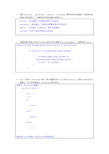
1.简述 private、 protected、 public、 internal 修饰符的访问权限, 并简述考虑资源占用的情况下, 对修饰符的使用需要注意些什么.3.try {}里有一个return语句,那么紧跟在这个try后的finally {}里的code会不会被执行,什么时候被执行,在return前还是后?4.您了解设计模式么?请列出您所知道的设计模式的名称。
5.在下面的例子里using System;class A{public A(){PrintFields();}public virtual void PrintFields(){}}class B:A{int x=1;int y;public B(){y=-1;}public override void PrintFields(){Console.WriteLine("x={0},y={1}",x,y);}}当使用new B()创建B的实例时,产生什么输出?6.下面这段代码输出什么?为什么?int i=5;int j=5;if (Object.ReferenceEquals(i,j))Console.WriteLine("Equal");elseConsole.WriteLine("Not Equal");9. 阅读以下说明和图,回答问题1至问题4。
【说明】某高校欲开发一个成绩管理系统,记录并管理所有选修课程的学生的平时成绩和考试成绩,其主要功能描述如下:1. 每门课程都有3到6个单元构成,每个单元结束后会进行一次测试,其成绩作为这门课程的平时成绩。
课程结束后进行期末考试,其成绩作为这门课程的考试成绩。
2. 学生的平时成绩和考试成绩均由每门课程的主讲教师上传给成绩管理系统。
3. 在记录学生成绩之前,系统需要验证这些成绩是否有效。
首先,根据学生信息文件来确认该学生是否选修这门课程,若没有,那么这些成绩是无效的;如果他的确选修了这门课程,再根据课程信息文件和课程单元信息文件来验证平时成绩是否与这门课程所包含的单元相对应,如果是,那么这些成绩是有效的,否则无效。
Image j 基本操作
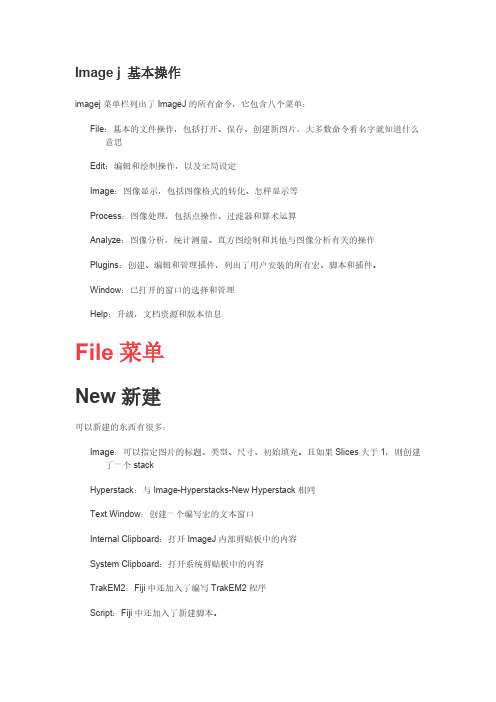
Image j 基本操作imagej菜单栏列出了ImageJ的所有命令,它包含八个菜单:File:基本的文件操作,包括打开、保存、创建新图片,大多数命令看名字就知道什么意思Edit:编辑和绘制操作,以及全局设定Image:图像显示,包括图像格式的转化、怎样显示等Process:图像处理,包括点操作、过滤器和算术运算Analyze:图像分析,统计测量、直方图绘制和其他与图像分析有关的操作Plugins:创建、编辑和管理插件,列出了用户安装的所有宏、脚本和插件。
Window:已打开的窗口的选择和管理Help:升级,文档资源和版本信息File菜单New新建可以新建的东西有很多:Image:可以指定图片的标题、类型、尺寸、初始填充。
且如果Slices大于1,则创建了一个stackHyperstack:与Image-Hyperstacks-New Hyperstack相同Text Window:创建一个编写宏的文本窗口Internal Clipboard:打开ImageJ内部剪贴板中的内容System Clipboard:打开系统剪贴板中的内容TrakEM2:Fiji中还加入了编写TrakEM2程序Script:Fiji中还加入了新建脚本。
Open打开可以打开的东西也有很多:常见图片,后缀有TIFF、GIF、JPEG、DICOM、BMP、PGM和FITS格式。
也可以通过插件打开额外的后缀的图片ImageJ和NIH的图片查询表,后缀是.lut以制表符分割的表格,后缀是.xls和.csv选区,后缀是.roi和.zip文本文件,后缀是.txt、.ijm、.js和.java其他Open Next打开下一个关闭当前图片,打开目录中的下一个图片(如果有的话)。
按住Alt打开目录中的前一个图片(如果有的话)。
Open Samples打开样例打开ImageJ服务器上的样例图片,可以用来测试宏、脚本、插件等。
Open Recent打开最近文件子菜单会显示最近15个打开的文件,可以选择其中一个。
公司理财被删除课后题第7章

10.Internal Rate of ReturnProjects A and B have the following cash flows:230YEAR PROJECT A PROJECT B 0Ϫ$1,000Ϫ$2,0001C1A C1B 2C2A C2B 3C3AC3BYEAR PROJECT A PROJECT B0Ϫ$7,500Ϫ$5,00014,0002,50023,5001,20031,5003,000a.If the cash flows from the projects are identical, which of the two projects would have a higher IRR? Why?b.If C1B ϭ2C1A, C2B ϭ2C2A, and C3B ϭ2C3A, then is IRR A ϭIRR B ? Present Value You are evaluating two projects, Project A and Project B . Project A has ashort period of future cash flows, while Project B has relatively long future cash flows. Which project will be more sensitive to changes in the required return? Why?12.Modified Internal Rate of Return One of the less flattering interpretations of the acronymMIRR is “meaningless internal rate of return.” Why do you think this term is applied to MIRR? Present Value One potential criticism of the net present value technique is that there is animplicit assumption that this technique assumes the intermediate cash flows of the project are reinvested at the required return. In other words, if you calculate the future value of theintermediate cash flows to the end of the project at the required return, sum the future values,and find the net present value of the two cash flows, you will get the same net present value as the original calculation. If the reinvestment rate used to calculate the future value is lower than the required return, the net present value will decrease. How would you evaluate this criticism?14.Internal Rate of Return One potential criticism of the internal rate of return technique is thatthere is an implicit assumption that this technique assumes the intermediate cash flows of the project are reinvested at the internal rate of return. In other words, if you calculate thefuture value of the intermediate cash flows to the end of the project at the required return, sum the future values, and calculate the internal rate of return of the two cash flows, you will get the same internal rate of return as the original calculation. If the reinvestment rate used to calculate the future value is different than the internal rate of return, the internal rate of return calculated for the two cash flows will be different. How would you evaluate this criticism?Q U E S T I O N S A N D P R O B L E M S1.Calculating Payback Period and NPV Fuji Software, Inc., has the following mutually exclusiveprojects.a.Suppose Fuji’s payback period cutoff is two years. Which of these two projects should be chosen?b.Suppose Fuji uses the NPV rule to rank these two projects. Which project should be chosen if the appropriate discount rate is 15 percent?/rwjBasic(Questions 1–10)17.Profitability Index versus NPV Hanmi Group, a consumer electronics conglomerate, isreviewing its annual budget in wireless technology. It is considering investments in three different technologies to develop wireless communication devices. Consider the following cashflows of the three independent projects for Hanmi. Assume the discount rate for Hanmi is10 percent. Further, Hanmi Group has only$30 million to invest in new projects this year.234Cash Flows (in $ millions)YEAR CDMA G4WI-FI0Ϫ$10Ϫ$20Ϫ$ 30125202021550403540100a.Based on the profitability index decision rule, rank these investments.b.Based on the NPV, rank these investments.c.Based on your findings in (a) and (b), what would you recommend to the CEO of Hanmi Groupand why?paring Investment Criteria Consider the following cash flows of two mutually exclusiveprojects for AZ-Motorcars. Assume the discount rate for AZ-Motorcars is 10 percent.a.Based on the payback period, which project should be taken?b.Based on the NPV, which project should be taken?c.Based on the IRR, which project should be taken?d.Based on the above analysis, is incremental IRR analysis necessary? If yes, please conductthe analysis.paring Investment Criteria The treasurer of Amaro Canned Fruits, Inc., has projected thecash flows of projects A, B, and C as follows.Suppose the relevant discount rate is 12 percent a year.pute the profitability index for each of the three projects.pute the NPV for each of the three projects.c.Suppose these three projects are independent. Which project(s) should Amaro acceptbased on the profitability index rule?d.Suppose these three projects are mutually exclusive. Which project(s) should Amaro acceptbased on the profitability index rule?e.Suppose Amaro’s budget for these projects is $300,000. The projects are not divisible. Whichproject(s) should Amaro accept?YEAR AZM MINI-SUV AZF FULL-SUV0Ϫ$200,000Ϫ$500,0001200,000200,0002150,000300,0003150,000300,000YEAR PROJECT A PROJECT B PROJECT C0Ϫ$100,000Ϫ$200,000Ϫ$100,000170,000130,00075,000270,000130,00060,000/rwj/rwjparing Investment Criteria Consider the following cash flows of two mutually exclusiveprojects for Tokyo Rubber Company. Assume the discount rate for Tokyo Rubber Company is10percent.YEAR DRY PREPREG SOLVENT PREPREG0Ϫ$1,000,000Ϫ$500,0001600,000300,0002400,000500,00031,000,000100,000a.Based on the payback period, which project should be taken?b.Based on the NPV, which project should be taken?c.Based on the IRR, which project should be taken?d.Based on the above analysis, is incremental IRR analysis necessary? If yes, please conductthe analysis.paring Investment Criteria Consider two mutually exclusive new product launch projectsthat Nagano Golf is considering. Assume the discount rate for Nagano Golf is 15 percent.Project A:Nagano NP-30Professional clubs that will take an initial investment of $100,000 at time 0.Next five years (years 1–5) of sales will generate a consistent cash flowof $40,000 per year.Introduction of new product at year 6 will terminate further cash flows fromthis project.Project B:Nagano NX-20High-end amateur clubs that will take an initial investment of $30,000 attime 0.Cash profit at year 1 is $20,000. In each subsequent year cash flow willgrow at 15 percent per year.Introduction of new product at year 6 will terminate further cash flows fromthis project.YEAR NP-30NX-200Ϫ$100,000Ϫ$30,000140,00020,000240,00023,000340,00026,450440,00030,418540,00034,980Please fill in the following table:NP-30NX-20IMPLICATIONSNPVIRRIncremental IRRPI235paring Investment Criteria Consider two mutually exclusive R&D projects that ADM isconsidering. Assume the discount rate for ADM is 15 percent.Project A:Server CPU .13 micron processing projectBy shrinking the die size to .13 micron, ADM will be able to offer server CPUchips with lower power consumption and heat generation, meaning fasterCPUs.Project B:New telecom chip projectEntry into this industry will require introduction of a new chip for cellphones.The know-how will require a large amount of upfront capital, but successof the project will lead to large cash flows later on.236YEAR A B0Ϫ$100,000Ϫ$200,000150,00060,000250,00060,000340,00060,000430,000100,000520,000200,000Please fill in the following table:paring Investment Criteria You are a senior manager at Poeing Aircrafts and have beenauthorized to spend up to $200,000 for projects. The three projects that you are considering have the following characteristics:Project A:Initial investment of$150,000.Cashflow of$50,000at year1and$100,000at year2.This is a plant expansion project,where the required rate of return is10percent.Project B:Initial investment of $200,000. Cash flow of $200,000 at year 1 and $111,000 atyear 2.This is a new product development project, where the required rate of return is20 percent.Project C:Initial investment of $100,000. Cash flow of $100,000 at year 1 and $100,000 atyear 2.This is a market expansion project,where the required rate of return is20percent.Assume the corporate discount rate is 10 percent.Please offer your recommendations, backed by your analysis.A B IMPLICATIONSNPVIRRIncremental IRRPIA B C IMPLICATIONSPaybackIRRIncremental IRRPINPV/rwj24.Payback and NPV An investment under consideration has a payback of seven years and acost of $483,000. If the required return is 12 percent, what is the worst-case NPV? The best-case NPV? Explain. Assume the cash flows are conventional.25.Multiple IRRs This problem is useful for testing the ability of financial calculators andcomputer software. Consider the following cash flows. How many different IRRs are there?(Hint:Search between 20 percent and 70 percent.) When should we take this project?237Challenge(Questions 24–30)YEAR CASH FLOW 0Ϫ$50412,8622Ϫ6,07035,7004Ϫ2,00026.NPV Valuation The Yurdone Corporation wants to set up a private cemetery business.Accordingto the CFO,Barry M.Deep,business is “looking up.”As a result,the cemetery project will provide a net cash inflow of $50,000for the firm during the first year,and the cash flows are projected to grow at a rate of 6percent per year forever.The project requires an initial investment of $780,000.a.If Yurdone requires a 13 percent return on such undertakings, should the cemetery business be started?b.The company is somewhat unsure about the assumption of a 6 percent growth rate in its cash flows. At what constant growth rate would the company just break even if it still required a 13 percent return on investment?27.Calculating IRR The Utah Mining Corporation is set to open a gold mine near Provo, Utah.According to the treasurer, Monty Goldstein, “This is a golden opportunity.” The mine will cost $600,000 to open and will have an economic life of 11 years. It will generate a cash inflow of $100,000 at the end of the first year and the cash inflows are projected to grow at 8 percent per year for the next 10 years. After 11 years, the mine will be abandoned. Abandonment costs will be $50,000 at the end of year 11.a.What is the IRR for the gold mine?b.The Utah Mining Corporation requires a 10 percent return on such undertakings. Should the mine be opened?28.Calculating IRR Consider two streams of cash flows, A and B . Stream A ’s first cash flow is$5,000 and is received three years from today. Future cash flows in stream A grow by 4 percent in perpetuity. Stream B ’s first cash flow is Ϫ$6,000 and is received two years from today and will continue in perpetuity. Assume that the appropriate discount rate is 12 percent.a.What is the present value of each stream?b.Suppose that the two streams are combined into one project, called C . What is the IRR of project C ?c.What is the correct IRR rule for project C ?29.Calculating Incremental Cash FlowsDarin Clay, the CFO of , has to decidebetween the following two projects:YEAR PROJECT MILLIONPROJECT BILLION0Ϫ$1,500Ϫ$I o 1I o ϩ200I o ϩ50021,2001,50031,5002,000/rwjThe expected rate of return for either of the two projects is 12 percent. What is the range of initial investment (I o ) for which Project Billion is more financially attractive than Project Million?30.Problems with IRR McKeekin Corp. has a project with the following cash flows:YEAR CASH FLOW 0$20,0001Ϫ26,000213,000What is the IRR of the project? What is happening here?W H AT ’S O N T H E W E B ? Present Value You have a project that has an initial cash outflow of Ϫ$20,000 and cash inflows of $6,000, $5,000, $4,000, and $6,000, respectively, for the next four years. Go to , and follow the “Online IRR NPV Calculator” link. Enter the cash flows. If the required return is 12 percent, what is the IRR of the project? The NPV?2.Internal Rate of Return Using the online calculator from the previous problem, find the IRR for a project with cash flows of Ϫ$500, $1,200, and Ϫ$400. What is going on here?B U L L OC K G O LD M I N I N GSeth Bullock, the owner of Bullock Gold Mining, is evaluating a new gold mine in South Dakota.Dan Dority, the company’s geologist, has just finished his analysis of the mine site. He has esti-mated that the mine would be productive for eight years, after which the gold would be com-pletely mined. Dan has taken an estimate of the gold deposits to Alma Garrett, the company’s financial officer. Alma has been asked by Seth to perform an analysis of the new mine and pre-sent her recommendation on whether the company should open the new mine.Alma has used the estimates provided by Dan to determine the revenues that could be ex-pected from the mine. She has also projected the expense of opening the mine and the annual operating expenses. If the company opens the mine, it will cost $500 million today, and it will have a cash outflow of $80 million nine years from today in costs associated with closing the mine and reclaiming the area surrounding it. The expected cash flows each year from the mine are shown in the table on the next page. Bullock Mining has a 12 percent required return on all of its gold mines.238C L O S I N G C A S E/rwjYEAR CASH FLOW0Ϫ$500,000,000160,000,000290,000,0003170,000,0004230,000,0005205,000,0006140,000,0007110,000,000870,000,0009Ϫ80,000,0001.Construct a spreadsheet to calculate the payback period, internal rate of return, modifiedinternal rate of return, and net present value of the proposed mine.2.Based on your analysis, should the company open the mine?3.Bonus question: Most spreadsheets do not have a built-in formula to calculate the paybackperiod. Write a VBA script that calculates the payback period for a project.239。
第十讲Swingppt课件
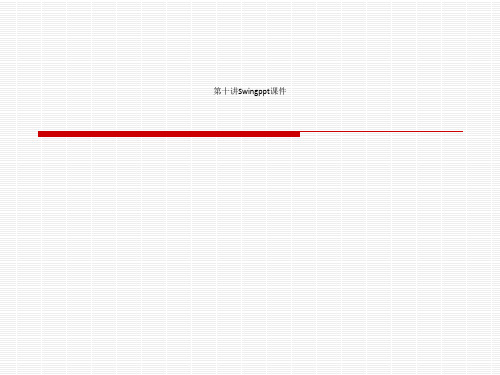
Swing简介
AWT是Swing的基础。Swing的产生主要原 因就是AWT不能满足图形化用户界面发展的 需要。
AWT设计的初衷是支持开发小应用程序的简 单用户界面。例如AWT缺少剪贴板、打印支 持、键盘导航等特性,而且原来的AWT甚至 不包括弹出式菜单或滚动窗格等基本元素。
Swing组件的分类
JComponent类的特殊功能又分为:
1) 边框设置:使用setBorder()方法可以设置组件外围的边框, 使用一个EmptyBorder对象能在组件周围留出空白。
2) 双缓冲区:使用双缓冲技术能改进频繁变化的组件的显示效 果。与AWT组件不同,JComponent组件默认双缓冲区,不必 自己重写代码。如果想关闭双缓冲区,可以在组件上施加 setDoubleBuffered(false)方法。
Swing简介
Swing外观感觉采用可插入的外观感觉 (Pluggable Look and Feel,PL&F)
在AWT组件中,由于控制组件外观的对等类 与具体平台相关,使得AWT组件总是只有与 本机相关的外观。Swing使得程序在一个平 台上运行时能够有不同的外观。用户可以选 择自己习惯的外观。以下三幅图是在同一个 操作系统下得到不同的外观。
Jpanel contentPane=new Jpanel( ); ……//把其它组件添加到Jpanel中; frame.setContentPane(contentPane); //把contentPane对象设置成为frame的内容面板
4、SwingBiblioteka 容器--Frame根面板提供的方法: Container getContentPane(); //获得内容面板 setContentPane(Container); //设置内容面 JMenuBar getMenuBar( ); //活动菜单条 setMenuBar(JMenuBar); //设置菜单条 JLayeredPane getLayeredPane(); //获得分层面板 setLayeredPane(JLayeredPane); //设置分层面板 Component getGlassPane(); //获得玻璃面板 setGlassPane(Component); //设置玻璃面板
内能
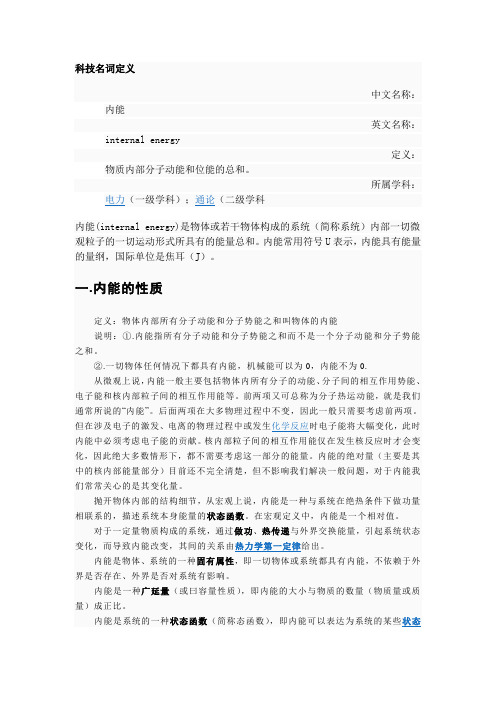
科技名词定义中文名称:内能英文名称:internal energy定义:物质内部分子动能和位能的总和。
所属学科:电力(一级学科);通论(二级学科内能(internal energy)是物体或若干物体构成的系统(简称系统)内部一切微观粒子的一切运动形式所具有的能量总和。
内能常用符号U表示,内能具有能量的量纲,国际单位是焦耳(J)。
一.内能的性质定义:物体内部所有分子动能和分子势能之和叫物体的内能说明:①.内能指所有分子动能和分子势能之和而不是一个分子动能和分子势能之和。
②.一切物体任何情况下都具有内能,机械能可以为0,内能不为0.从微观上说,内能一般主要包括物体内所有分子的动能、分子间的相互作用势能、电子能和核内部粒子间的相互作用能等。
前两项又可总称为分子热运动能,就是我们通常所说的“内能”。
后面两项在大多物理过程中不变,因此一般只需要考虑前两项。
但在涉及电子的激发、电离的物理过程中或发生化学反应时电子能将大幅变化,此时内能中必须考虑电子能的贡献。
核内部粒子间的相互作用能仅在发生核反应时才会变化,因此绝大多数情形下,都不需要考虑这一部分的能量。
内能的绝对量(主要是其中的核内部能量部分)目前还不完全清楚,但不影响我们解决一般问题,对于内能我们常常关心的是其变化量。
抛开物体内部的结构细节,从宏观上说,内能是一种与系统在绝热条件下做功量相联系的,描述系统本身能量的状态函数。
在宏观定义中,内能是一个相对值。
对于一定量物质构成的系统,通过做功、热传递与外界交换能量,引起系统状态变化,而导致内能改变,其间的关系由热力学第一定律给出。
内能是物体、系统的一种固有属性,即一切物体或系统都具有内能,不依赖于外界是否存在、外界是否对系统有影响。
内能是一种广延量(或曰容量性质),即内能的大小与物质的数量(物质量或质量)成正比。
内能是系统的一种状态函数(简称态函数),即内能可以表达为系统的某些状态参量(例如压强、体积等)的某种特定的函数,函数的具体形式取决于具体的物质系统(具体地说,取决于物态方程)。
J-Integral
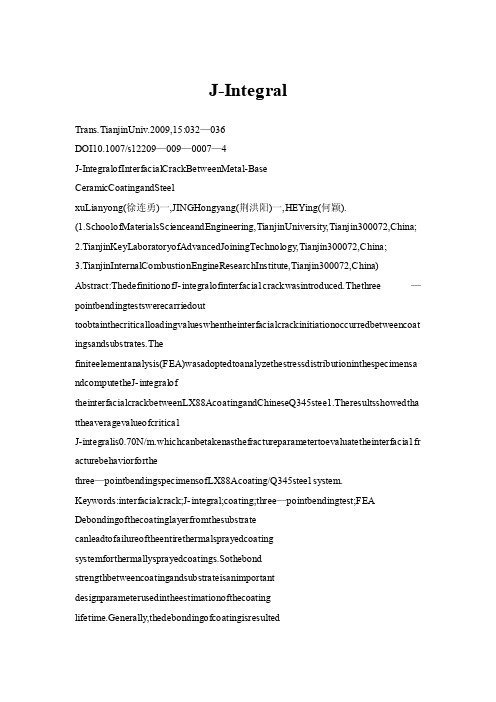
J-IntegralTrans.TianjinUniv.2009,15:032—036DOI10.1007/s12209—009—0007—4J-IntegralofInterfacialCrackBetweenMetal-BaseCeramicCoatingandSteelxuLianyong(徐连勇)一,JINGHongyang(荆洪阳)一,HEYing(何颖).(1.SchoolofMaterialsScienceandEngineering,TianjinUniversity,Tianjin300072,China;2.TianjinKeyLaboratoryofAdvancedJoiningTechnology,Tianjin300072,China;3.TianjinInternalCombustionEngineResearchInstitute,Tianjin300072,China) Abstract:ThedefinitionofJ-integralofinterfacia1crackwasintroduced.Thethree—pointbendingtestswerecarriedout toobtainthecriticalloadingvalueswhentheinterfacialcrackinitiationoccurredbetweencoat ingsandsubstrates.Thefiniteelementanalysis(FEA)wasadoptedtoanalyzethestressdistributioninthespecimensa ndcomputetheJ-integraloftheinterfacialcrackbetweenLX88AcoatingandChineseQ345stee1.Theresultsshowedtha ttheaveragevalueofcritica1J-integralis0.70N/m.whichcanbetakenasthefractureparametertoevaluatetheinterfacia1fr acturebehaviorforthethree—pointbendingspecimensofLX88Acoating/Q345stee1system.Keywords:interfacialcrack;J-integral;coating;three—pointbendingtest;FEA Debondingofthecoatinglayerfromthesubstrate canleadtofailureoftheentirethermalsprayedcoating systemforthermallysprayedcoatings.Sothebond strengthbetweencoatingandsubstrateisanimportant designparameterusedintheestimationofthecoatinglifetime.Generally,thedebondingofcoatingisresultedfromtheextendingofcracksordefectsintheinterface betweencoatingandsubstrate.Therefore,itisnecessary tomeasurebondstrengthusingtheinterfacialfracture mechanicsapproachandfindthefracturecontrolledpa—rameter.Obviously,itisatypicalbi—materialinterface problem.Atpresent,thebendingtests[-]areusedtomeasure thefracturetoughnessofinterfacebetweencoatingsand substratesbymanyresearchers.Whenthecriticalinterfa—cialstressintensityfactor(Kc)orcriticalinterfacia1en—ergyreleaserate(Gc)areusedasthefractureparameters, thecoatings/substratessystemsareexpectedtobehard elasticcoatings/hardelasticsubstrates.Ifthesubstrates areveryflexiblethelargescaleyielding(LSY)would occurinthesubstratesneartheinterfacialcracktipwhen theinterfacialcrackpropagationinitiates.Soitisre—quiredthatthespecimensbetestedwithintheelastic limitofthesubstrates.Forthehardelasticcoat.ings/flexibleelastic-plasticsubstrates,theJ-integralof interfacialcracktipisstudiedasthefractureparameter fortheevaluationofinterfacialtoughnessintherangeof theelastic-plasticfracturemechanics【12-14]. Inthisstudy,thefracturemechanicsexperiments andtheFEAwereadoptedtocomputetheJ-integralof theinterfacialcrackbetweenLX88AcoatingandChinese Q345steel,andthevalidityoftheJ-integralasinterfacial fractureparametersforthree—pointbendingspecimens wasdiscussed.1J-integraloftheinterfacialcrackTheJ-integraliswidelyusedasafracturemechan—icsparameterforbothlinearandnonlinearmaterialre—sponse,anditisdefinedthroughtheenergyreleaserate associatedwithcrackgrowth【,们.Foravirtualcrackadvance2(s)intheplaneofathree—dimensionalcrackinabody,theenergyreleaserateisgivenby=()nHqdA(1)wheredAisasurfaceelementonavanishinglysmall tubularsurfaceenclosingthecracktip;isoutwardlynormaltodA;gisaunitvectorinthelocalvirtualcrackextentiondirection;Hisgivenby:WI一(2)Accepteddate:2007—11—29. SupportedbyTianjinNaturalScienceFoundation(No08JCYBJC09100),NewTeacherRes earchFundfortheDoctoralProgramofHigherEducationofChinafNo200700560961andNewCenturyOutstandingTalentedPers onPlanofChina.XULianyong,bornin1975,male,DrcorrespondencetoJINGHongyang,E—mail:***************XULianyongetahJ-IntegralofInte咖cialCrackBetweenMetal—BaseCeramicCoatingandSteelForelasticmaterialbehavior,Wistheelasticstrainenergy;forelastic—plasticmaterialbehavior,Wisdefined astheelasticstrainenergyplustheplasticdissipation, thusrepresentsthestrainenergyinanequivalentelasticmateria1.ThisimpliesthattheJ-integralcalculationis suitableonlyformonotonicloadingofelastic—plasticma.ingtheFEAresults,theJ-integralvalueoftheinterfacia1crackcanbeachievedthroughtheintegralof Eq.(1)alongthepathABDBAorEFGFE)inFig.1£Fig.1J-integralpathofinterracialcracktipbetween coatingandsubstrateInaddition.theJ-integralcanbeusedtoanalyzethe fracturebehaviorasthefractureparameterwhentheJ- integralvaluekeepsconservationaccordingtothefrac—turemechanicstheory.WangPtl[171discussedthecon. servationofJ-integralneartheinterfacialcracktip,and confirmedtheconservationusingthenumericalmethod. 2Fracturemechanicsexperiment2.1SpecimenspreparationADZ—-ARC?-400high@tarc??spraysystemwasused toproducethecommercialmetal—baseceramiccoating (LX88A)onthebasemetal(ChineseQ345stee1).The chemica1constitutionsofChineseO345steelandLX88A coatingarepresentedinTab.1andTab.2,respectively. Inthetest,thethree—pointbendingspecimenswere used.Thespecimenconsistsofabi.materialbeam(coat—ingandsubstrate)anditsconfigurationisshowninFig.2.Thecoatingthicknessisabout1.20mm.Thedi—mensionofthesubstrateforthethree—pointbendingtest is100minx9.7mmX9.11Tlnlinlength,widthandthick—ness.respectively.Acentralnotchwhosewidthis0.5 mmwasintroducedacrossthecentralportionofthe specimenusingwireEDM(electricaldischargemachin—ing)technologythroughthethicknessofthecoating.A fatiguecrackalongtheinterfacewasthencreatedfrom thebaseofthenotchonafatigueloadingtestingma-chine.Forthepurposeofanalysis,subscript1indicates thecoating,whereassubscript2denotesthesubstrate. Tab.1ConstitutionofChineseQ345stee1%Tab.2ConstitutionofLX88Acoating%Fig.2Bi—material,notchedthree—pointbendingspecimen withsymmetricalinterfacialcrack2.2Testprocess Threespecimenswerepreparedforthebendingtest. ThespecimenNo.1withthepre—interfacialcrackwas loadedonauniversal—testingmachine(CSS.44100).In theload.onprocess.thevicinityofinterfacialcracktip wasobservedthroughamicro—telescope(Fig.3)inorder toobtainthecriticalloadwhentheinterfacialcrackini—tiationoccurred.Themicro—telescopewasabletotravel inthree—dimensionalorientations.soitcantracethecrack tippositionofthespecimenintheload—onprocess.The imageofcracktipvicinitycanbedisplayedinthecorn—puterscreenthroughaCCDandanimagecollector. Whentheobviouscrackgrowingoccurred,thetestwas ceased.Theloadneededtoberecorded.anditwastaken asthecriticalloadresultingincrackinitiation.Inorderto Fig.3Micro?-telescopeobservingthecracktipofspeci-- menintheload—onprocess一33—TransactionsofTianjinUniversityV o1.15No.2009 observethecrackinitiation.amarking1inehadbeen scratchedaheadofthepre.cracktip.Fig.4isthemicrophotographsofthespecimenNo.1 beforeandaftercrackinitiation.Beforecrackinitiationthedistancebetweencracktipandthemarkinglinewas 0.541mm;aftercrackinitiation,thedistancebecame 0.237mm.ThecracktipmovedtotheleftfromFig.4(a) toFig.4(b).Sotheinterfacialcrackgrewnoticeably.(a)Beforecrackinitiation(b)AtiercrackinitiationFig.4Micr0ph0t0graphsofspecimenNo.1beforeand aftercrackinitiation2.3Testresults Thecriticalloadvaluesofthethreespecimenswhen theinterfacialfractureoccurredarelistedinTab.3. Tab.3Criticalloadofspecimens3Resultsanddiscussion3.1Numericalanalysis Symmetriesaboutthemidsectionsofthebeamde- pictedinFig.2allowtherequisitesolutionstobeOb—tainedbyconsideringaquarterofthecompositebeam (Fig.5(a)).Thefiniteelementsare20一nodequadratic brick,reducedintegrationelements;oneelementhas8 integrationpoints.Themeshofthewholemodelforthis specimenispresentedinFig.5(a).Themeshbecomes denserintheareasurroundingthecracktipandnearthe 一34一interface.Asmallrectangulararea(1mm×1mm) aroundthecracktipwasspeciallyrefined.Thereare threerefinedtipmeshes.Thefinestmeshhas10layers, eachlayerhas32elements;thefinermeshhas8layers, eachlayerhas24elements(aspresentedinFig.5(b)): thecoarsestmeshhas6layers.eachlayerhasl6ele-ments.Thesmallestelementdimensionofthethreere—finedmeshesis0.006mmx0.01mm×0.12mm.0.0lmm×0.016mm×0.12mmand0.015mm×0.02mm×0.12mrn.respectively.TheFEMresultsshowsthestress fieldsnearthecracktipbyusingthethreerefinedmeshesarealmostidentica1.soonlythefinermeshisexhibitedinFig.5.AsshowninFig.5(b),arefinedfocusedmeshis usedintheimmediatevicinityofthecrack.tiDsur—roundedbyarosetteofsingularquarterpointelementsin ordertocapturetheexpectedsquarerootsingularstresses.Arollersupportfixedtheverticaldisplacementatthesupportpoint,whereassymmetrieswereenforcedby inhibitinghorizontaldisplacementsalongthemidsectionofthesubstratelayerinX-directionandbyinhibitingZ- directionaldisplacementalongthemidsectionofthespecimeninZ-direction.Thecracksurfacesweretrac—tion—free.Thethree.dimensionalfiniteelementsolutionswere obtainedwiththegeneralpurposefiniteelementsoftwareABAQUSV ersion6.5一1.1nteInfa1Totalmodelandcracktiptingftrate~(b)ThecracktipregionFig.5Meshusedinthree—dimensionalfiniteelementanalysisXULianyongeta1.J-IntegralofInterfacialCrackBetweenMetal-BaseCeramicCoatingandSteelIntheFEA,theappliedloadvaluewasthecriticaling/Q345steelsystem. Ioadvalueobtainedfrompreviousexperiment.The analysiswaselastic-plastic.Thematerial—propertiesareReferencessh0wninTab.4andFig?6?[1]chara1ambidesPG,LundJ,EvansAG,.Atest Tab.4Materialpropertiesinfracturetest/.1Note:Thecoatingisthelinear-elasticmateria1.IntheFEA,the assumptionthattheyieldstrengthofthecoatingisequaltoavery largevalueismadetoensHrethelinear-elasticdeformbehavior.Fig.6Truestress—straincurveofQ345steel3.2jr-integralofinterfacialcrackAfterthethree.dimensionalfiniteelementanalysis.theJ-integralvaluesofallthespecimenswerecalculated usingthesubroutineintheABAQUSprogram,andthe resultsarelistedinTab.6.Theaveragevalueofis0.70N/m.andtheJ-integralcanbetakenasthefracturepa—rametertoevaluatetheinterfacialfracturebehaviorforthethree-pointbendingspecimensofLX88Acoat.ing/Q345steeIsystem.Tab.6J-integralofinterfacialcracktip4Conclusions Thethree—pointbendingspecimenscontainingthe pre—interfacialcracksintheinterfacebetweentheLX88A coatingandQ345steelwereusedinthefracturemechan. iesexperiments.Thefiniteelementmethodwasadopted toanalyzethestressdistributionofthespecimens.TheJ- integraloftheinterfacecrackwascalculatedbasedonthe FEAresults.Theresultsshowedthattheaveragevalueofis0.70N/mandtheJ-integralcanbetakenasthefrac.tureparametertoevaluatethejnterfacia1fracturebehav—iorforthethree.pointbendingspecimensofLX88Acoat—specimenfordeterminingthefractureresistanceofbimate—rialinterfaces[J].JournalofAppliedMechanics.Transac—tionsoftheASME,1989,56(1):77—82.2JChungHGP,SwainMV,MoriT.Evaluationofthestrain energyreleaserateforthefractureoftitanium..porcelainin.. terfacialbondingEJ].Biomaterials,1997,18(23):1553一l557.13JLiH,KhorKA.CheangP.Y oung'smodulusandfracture toughnessdeterminationofhighvelocityoxy--fuel-?sprayed bioceramiccoatings[J].Su咖ceandCoatingsTechnology, 2002.155(1):21.32.【4jO'DowdNP,ShihCF,StoutMG.Testgeometriesfor measuringinterfacialfracturetoughness[J].International JournalofSolidsandStructures,1992,29(5):571.589.15JBeckerJrTL,McNaneyJM,CannonRMela1. Limitationsontheuseofthemixed.modedelaminating beamtestspecimen:EffectsofthesizeoftheregionofK—dominance[J].MechanicsofMaterials,1997,25(4):291—308.16J0hTaeSung,CannonRMRitchieRO.Subcriticalcrack growthalongceramic—metalinterfaces[J].Journalofthe AmericanCeramicSociety,1987,70(12):C352一C355. 17JCannonRM,DalgleishBJ,DauskardtRHela1.Cyclic fatigue—crackpropagationalongceramic/metalinter. faces.ActaMetallurgicaetMaterialia,1991,39(8): 2145.2156.18JThunG,SchneiderGABahrHAeta1.Toughnessanisot—ropyanddamagebehaviorofplasmasprayedZrO2thermalbarriercoatings[J].SurfaceandCoatingsTechnology. 2000123(2/3):147—158,[9]CaoHC,EvansAG.Anexperimentalstudyoftheffac—tureresistanceofbi—materialinterfaces[J].Mechanicsof Materials,1989,7(4):295—304.【10JHowardSJ,PhillippsAJ,ClyneTW.Theinterpretation ofdatafromthefour—pointbenddelaminationtestto measureinterfacialfracturetoughness[J].Composites, 1993.24(2):103—112.111JMullerD,ChoYR,BergSeta1.Fracturemechanicstests formeasuringtheadhesionofmagnetronsputteredTiN coatingslJj.InternationalJournalofRefractoryMetals andHardMaterials,1996,14:207—211.[12]MoranB,ShihCF.Cracktipandassociateddomaininte—gralsfrommomentumandenergybalance[J].Engineering 一35—TransactionsoJndnJinUniversityV o1.15No.2009 FractureMechanics198727(6):6l5-642.ShihCF,AsaroRJ.Elastic—plasticanalysisofcrackson bi—materialinterfaces(PartI):Smallscaleyielding[J]. JournalofAppliedMechanics,TransactionsoftheASME, 198855(2):299—316.NakamuraT,ParksDM.DeterminationofelasticT—stress alongthree-?dimensionalcrackfrontusinginteractioninte-- grallJj.InternationalJournalofSolidsandStructures, 1992,29(13):1597—1611.ParksDM.Thevirtualcrackextensionmethodfornonlin—earmaterialbehaviour[puterMethodsinAppliedMechanicsandEngineeling,1977,12(3):353—364.一36一ShihCF,MoranB,NakamuraT.Energyreleaseratealong athree—dimensionalcrackfrontinathermallystressed body[J].InternationalJournalofFracture,1986,30(2): 79—1O2.WangLimin,ChenHaoran,XuShilang.Conservationlaw andapplicationofJ-integralinmulti—materials[J].Applied MaematicsandMechanics',2001.22(10):1097一l104. XuLianyong,JingHongyang,HuoLixing.Y oung'S modulusandstressintensityfactordeterminationofhigh velocityelectricarcsprayedmetal-basedceramiccoat?- ing[J].SurfaceandCoatingsTechnology2006,201(6): 2399—2406]J]J]jr.1rlr1]J]J]j345r.1rlrl。
JHipster技术栈理解-UAA原理分析

JHipster技术栈理解-UAA原理分析本⽂简要分析了UAA的认证机制和部分源码功能。
UAA全称User Account and Authentication。
相关源码都是通过Jhipster⽣成,包括UAA,Gateway,Identity。
Jhipster简介请。
1 OAuth2认证模式1.1 密码模式密码模式(Resource Owner Password Credentials)中,⽤户向客户端提供⾃⼰的⽤户名和密码。
客户端使⽤这些信息,向"认证服务器"进⾏认证。
在这种模式中,⽤户必须把⾃⼰的密码给客户端,但是客户端不得储存密码。
流程如下:a, ⽤户向客户端提供⽤户名和密码。
b, 客户端将⽤户名和密码发给认证服务器,向后者请求令牌。
c, 认证服务器确认⽆误后,向客户端提供访问令牌。
d, 客户端之后所有访问都会传递令牌。
1.2 客户端模式客户端模式(Client Credentials)指客户端以服务⾃⾝的名义,⽽不是以⽤户的名义,向"认证服务器"进⾏认证。
流程如下:a, 客户端从配置⽂件或者数据库获取认证信息。
b, 客户端将认证信息发给认证服务器,并请求返回⼀个访问令牌。
c, 认证服务器确认认证信息⽆误后,向客户端提供访问令牌。
d, 客户端之后的所有访问不会传递这个令牌。
2 UAA认证⽅式2.1 ⽤户调⽤oauth2认证模式:密码模式配置⽂件相关内容oauth2:web-client-configuration:#change client secret in production, keep in sync with UAA configurationclient-id: web_appsecret: changeit时序图说明:这种认证⽅式是⽤在⽤户访问的场景,也就是服务间调⽤时总是带着⽤户名和密码信息。
2.2 机器调⽤oauth2认证模式:客户端模式配置⽂件相关内容jhipster:security:client-authorization:client-id: internalclient-secret: internal时序图说明:这种认证⽅式是⽤在内部服务之间调⽤的场景,也就是服务间调⽤时是没有⽤户名和密码信息的。
计算机操作系统习题集
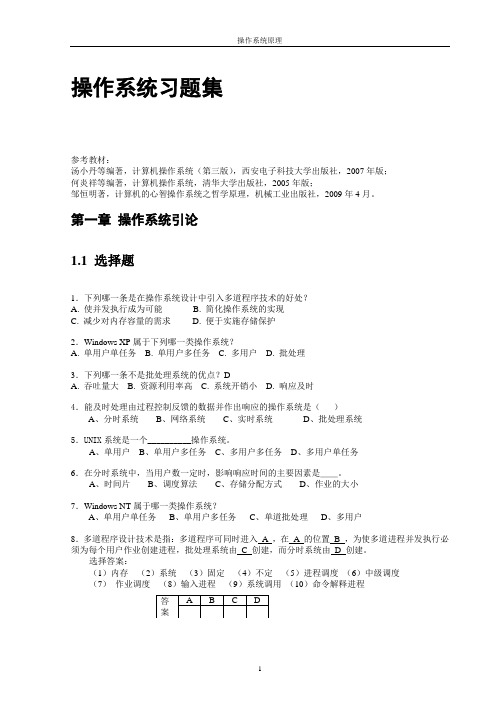
操作系统习题集参考教材:汤小丹等编著,计算机操作系统(第三版),西安电子科技大学出版社,2007年版;何炎祥等编著,计算机操作系统,清华大学出版社,2005年版;邹恒明著,计算机的心智操作系统之哲学原理,机械工业出版社,2009年4月。
第一章操作系统引论1.1 选择题1.下列哪一条是在操作系统设计中引入多道程序技术的好处?A. 使并发执行成为可能B. 简化操作系统的实现C. 减少对内存容量的需求D. 便于实施存储保护2.Windows XP属于下列哪一类操作系统?A. 单用户单任务B. 单用户多任务C. 多用户D. 批处理3.下列哪一条不是批处理系统的优点?DA. 吞吐量大B. 资源利用率高C. 系统开销小D. 响应及时4.能及时处理由过程控制反馈的数据并作出响应的操作系统是()A、分时系统B、网络系统C、实时系统D、批处理系统5.UNIX系统是一个__________操作系统。
A、单用户B、单用户多任务C、多用户多任务D、多用户单任务6.在分时系统中,当用户数一定时,影响响应时间的主要因素是__。
A、时间片B、调度算法C、存储分配方式D、作业的大小7.Windows NT属于哪一类操作系统?A、单用户单任务B、单用户多任务C、单道批处理D、多用户8.多道程序设计技术是指:多道程序可同时进入A ,在A 的位置B ,为使多道进程并发执行必须为每个用户作业创建进程,批处理系统由C 创建,而分时系统由D 创建。
选择答案:(1)内存(2)系统(3)固定(4)不定(5)进程调度(6)中级调度(7)作业调度(8)输入进程(9)系统调用(10)命令解释进程1.在手工操作阶段,操作员在进行装卸卡片或磁带等手工操作时,CPU处于空闲等待,我们称这种现象为。
2.多道批处理系统的特征为。
3.批量处理系统的缺点为;。
4.系统的出现,标志着操作系统的形成。
5.操作系统的基本类型有。
6.分时系统的特征为四个基本特征。
7.以多道程序设计为基础的现代操作系统具有。
I J开头的词汇用法

I开头的词汇用法.insignificant a. 无意义的,无足轻重的;无价值的)in-无+significant 有意义的,意义深长的--〉无关紧要的;无用的idea n.想法;思想;意见ideal a.理想的;观念的identical a.完全相同的;同一的identify vt.认出,识别,鉴定idiom n.习语,成语idle a.空闲的;懒散的i.e. (=that is)那就是,即if conj.假如,如果ignorant a.不知道的;无知的ignore vt.不顾,不理,忽视ill a.有病的;坏的ad.坏illegal a.不合法的,非法的illness n.病,疾病illustrate vt.(用图等)说明illustration n.说明,图解;例证image n.像;形象;映象imaginary a.想象中的,假想的imagination n.想象;想象力;空想imagine vt.想象,设想;料想imitate vt.模仿,仿效;仿制immediate a.立即的;直接的immediately ad.立即;直接地immense a.巨大的;极好的immigrant n.移民a.移民的impact n.影响,作用;冲击impatient a.不耐烦的,急躁的implication n.含义,暗示,暗指imply vt.暗示,意指import vt.&n.输入,进口importance n.重要;重要性important a.重要的;有势力的impose vt.把…强加;征(税)impossible a.不可能的,办不到的impress vt.给…深刻印象impression n.印;印象;印记impressive a.给人印象深刻的imprison vt.关押,监禁;限制improve vt.使更好vi.改善improvement n.改进,改善;改进处in prep.在…里ad.进,入inch n.英寸incident n.发生的事;事件incline n.斜坡vt.使倾斜include vt.包括,包含income n.收入;收益;进款incorrect a.不正确的,错误的increase vt.&vi.&n.增加increasingly ad.日益,越来越多地indeed ad.真正地;确实indefinite a.不明确的;不定的independence n.独立,自主,自立independent a.独立的;自主的index n.索引;指数;指标India n.印度Indian a.印度的n.印度人indicate vt.标示,表示;表明indication n.指示;表示;表明indifferent a.冷漠的;不积极的indignant a.愤慨的,义愤的indirect a.间接的;不坦率的indispensable a.必不可少的,必需的individual a.个别的;独特的indoors ad.在室内,在屋里industrial a.工业的;产业的industrialize vt.使工业化industry n.工业,产业;勤劳inefficient a.效率低的,无能的inevitable a.不可避免的,必然的inexpensive a.花费不多的,廉价的infant n.婴儿a.婴儿的infect vt.传染;感染infer vt.推论,推断;猜想inferior a.下等的;劣等的infinite a.无限的;无数的influence n.影响;势力vt.影响influential a.有影响的;有权势的inform vt.通知,向…报告information n.消息,信息;通知inhabit vt.居住于,栖息于inhabitant n.居民,住户inherit vt.继承(传统等)initial a.最初的;词首的injection n.注射,注入;充满injure vt.伤害,损害,损伤injury n.损害,伤害;受伤处ink n.墨水,油墨inn n.小旅店;小酒店inner a.内部的;内心的innocent a.清白的,幼稚的无效n.输入;投入的资金inquire vt.打听,询问;调查inquiry n.询问,打听;调查insect n.昆虫,虫insert vt.插入; 嵌入; 登载inside prep.在…里面n.内部insist vi.坚持;坚持要求inspect vt.检查,审查;检阅inspection n.检查,审查;检阅inspire vt.鼓舞;给…以灵感install vt.安装,设置installation n.安装;装置;设施instance n.例子,实例,事例instant n.瞬间a.立即的instantly ad.立即,即刻instead ad.代替,顶替;反而instinct n.本能;直觉;生性institute n.研究所;学院institution n.协会;制度,习俗包含uct vt.教;指示;通知包含uction n.命令;教学;教训包含ument n.仪器;工具;乐器insufficient a.不足的;不适当的insult vt.&n.侮辱,凌辱insurance n.保险;保险费insure vt.给…保险;确保intellectual n.知识分子a.智力的intelligence n.智力;理解力;情报intelligent a.聪明的;理智的intend vt.想要,打算;意指intense a.强烈的;紧张的intensity n.强烈,剧烈;强度intensive a.加强的;精耕细作的intention n.意图,意向,目的intentional a.故意的,有意识的interaction n.相互作用;干扰interest n.兴趣;利益;利息interesting a.有趣的,引人入胜的interfere vi.干涉,干预;妨碍interference n.干涉,干预;阻碍interior a.内的;内地的n.内部intermediate a.中间的;中级的internal a.内的;国内的international a.国际的,世界(性)的interpret vt.解释,说明;口译interpretation n.解释;口译interpreter n.译员,口译者interrupt vt.打断,打扰;中止interruption n.中断,打断;障碍物interval n.间隔;休息;间距interview n.接见;会见;面谈intimate a.亲密的;个人的into prep.进,入;进入到introduce vt.介绍;引进,传入introduction n.介绍;引进;引言invade vt.入侵,侵略;侵袭invasion n.入侵,侵略;侵犯invent vt.发明,创造;捏造invention n.发明,创造;捏造inventor n.发明者;发明家invest vt.投资;投入investigate vt.&vi.调查investigation n.调查,调查研究investment n.投资,投资额,投入invisible a.看不见的,无形的invitation n.邀请,招待;请柬invite vt.邀请,聘请;招待involve vt.使卷入;牵涉inward a.里面的ad.向内iron n.铁;烙铁vt.烫(衣)irregular a.不规则的;不整齐的island n.岛,岛屿isolate vt.使隔离,使孤立issue n.问题;发行vt.发行it pron.这,那,它item n.条,条款;一条its pron.它的itself pron.它自己;自身if的相关用法一、if作为连词,引导条件状语从句,它表示的意思是“假如”“如果”等。
内部控制国外学者发表的观点

内部控制国外学者发表的观点英文回答:Internal Control: Perspectives from International Scholars.Internal control is a critical component of any organization, as it helps to ensure the accuracy and reliability of financial reporting, safeguard assets, and promote operational efficiency. Over the years, numerous international scholars have conducted extensive research on internal control, offering valuable insights into its various aspects.Committee of Sponsoring Organizations of the Treadway Commission (COSO)。
The Committee of Sponsoring Organizations of the Treadway Commission (COSO) is a renowned organization that has significantly contributed to the development ofinternal control frameworks. COSO's Internal Control Integrated Framework (IC-IF) provides a comprehensive model for evaluating and improving internal control systems. The IC-IF consists of five components: control environment,risk assessment, control activities, information and communication, and monitoring.International Internal Control Framework (IICF)。
The interaction of internal and external information in a problem solving task
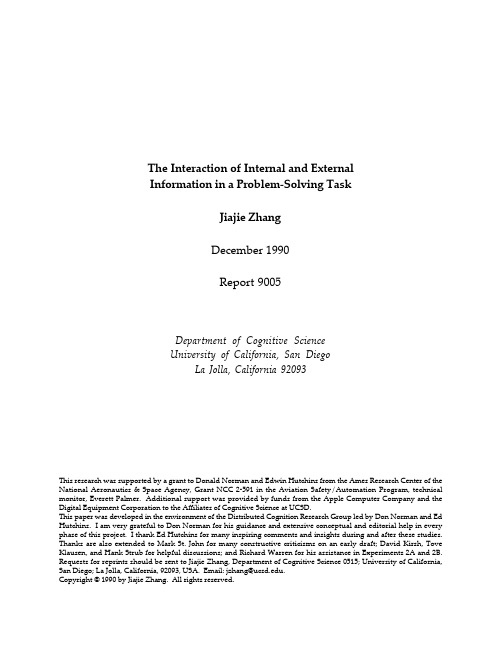
The Interaction of Internal and ExternalInformation in a Problem-Solving TaskJiajie ZhangDecember 1990Report 9005Department of Cognitive ScienceUniversity of California, San DiegoLa Jolla, California 92093This research was supported by a grant to Donald Norman and Edwin Hutchins from the Ames Research Center of the National Aeronautics & Space Agency, Grant NCC 2-591 in the Aviation Safety/Automation Program, technical monitor, Everett Palmer. Additional support was provided by funds from the Apple Computer Company and the Digital Equipment Corporation to the Affiliates of Cognitive Science at UCSD.This paper was developed in the environment of the Distributed Cognition Research Group led by Don Norman and Ed Hutchins. I am very grateful to Don Norman for his guidance and extensive conceptual and editorial help in every phase of this project. I thank Ed Hutchins for many inspiring comments and insights during and after these studies. Thanks are also extended to Mark St. John for many constructive criticisms on an early draft; David Kirsh, Tove Klausen, and Hank Strub for helpful discussions; and Richard Warren for his assistance in Experiments 2A and 2B. Requests for reprints should be sent to Jiajie Zhang, Department of Cognitive Science 0515; University of California, San Diego; La Jolla, California, 92093, USA. Email: jzhang@.Copyright © 1990 by Jiajie Zhang. All rights reserved.The Interaction of Internal and External Information in a Problem-Solving TaskJIAJIE ZHANG ABSTRACTIn these studies I examine the role of distributed cognition in problem solving. The major hypothesis explored is that intelligent behavior results from the interaction of internal cognition, external objects, and other people, where a distributed cognitive task can be represented as a set of modules, some internal and some external. The Tower of Hanoi problem is used as a concrete example for these studies. In Experiment 1 I ex-amine the effects of the distribution of rep-resentations among internal and external modules on problem-solving behavior. Experiments 2A and 2B focus on how the nature and number of rules affect problem-solving behavior. Experiment 3 investigates how a group’s problem-solving behavior is affected by the distribution of representations among the individuals. The results of all studies show that distributed cognitive activities are produced by the interaction among the representations in the modules involved in a given task: between internal and external representations and between internal representations. External representations are not peripheral aids. They are an indispensable part of cognition. Two of the factors determining the performance of a distributed cognitive system are the structure of the abstract task space and the distribution of representations across modules.INTRODUCTIONThe traditional approach to cognition in general and problem solving in particular focuses on an individual’s internal mental states. In the traditional view, representation and cognition are exclusively the activity of an internal mind. External objects, if they have anything to do with cognition at all, are at most peripheral aids. The cognitive properties of a group are solely determined by the structures internal to the individuals. There is no doubt that internal factors are important to cognition. They are not, however, the whole story. Much of a person’s intelligent behavior results from interactions with external objects and with other people. External and social factors also play critical roles in cognitive activities. Recently, cognitive scientists have started to address “distributed cognition,” the study of how cognitive activity is distributed across internal human minds, external cognitive artifacts, groups of people, and across space and time (Hutchins, 1990, in preparation; Hutchins & Norman, 1988; Norman, 1988, 1989, 1990). In the study of cognitive artifacts, Norman (1990) argues that artifacts not only enhance a person’s ability to perform a task, but theyalso change the nature of the task. In the study of the social organization of distributed cognition, Hutchins (1990) shows that social organizational factors often produce group properties that differ considerably from the properties of individuals.In this paper, I develop a framework, the modularity of representations, to analyze a set of distributed cognitive tasks, and to ex-plore the interactions among internal and external representations and among members of a group of people. I show that external objects are not simply peripheral aids— they provide a different form of representation. External representations are interwoven with internal representations to produce distributed cognitive activities. In addition, the share of knowledge among a set of modules is important for a system’s performance.Modularity of RepresentationsThe basic principle to be explored is that the representational system for a given task can be considered as a set, with some members internal and some external. Internal repre-sentations are in the mind, as propositions, mental images, or whatever (e.g., multipli-cation tables, arithmetic rules, logic, language, etc.). External representations are in the world, as physical symbols (e.g., written symbols, beads of an abacus, etc.) or as ex-ternal rules, constraints, or relations em-bedded in physical configurations (e.g., spa-tial relations of the items in a table, spatial configurations of the digits on a piece of pa-per, physical constraints in an abacus, etc.). The representations discussed in this paper are representations for tasks. In this sense, we can speak of not only internal represen-tations, which have their traditional meaning, but also external representations. For example, an external representation can represent the external part of the structure of a task. Generally, there are one or more internal and external representations involved in any task. Each representation is a relatively isolated functional unit in a specific medium. I call this unit, whether internal or external, a module.Figure 1 shows a representational system for a task with two internal and two external modules. Each internal module resides in a person’s mind and each external module resides in an external medium. The representations of internal and external modules involved in a given task together form a distributed representation space mapped to a single abstract task space that represents the properties of the problem. Each module sets some constraints on the abstract task space. The distributed repre-sentation space plays an important role in the studies reported here.The distributed cognition perspective demands the decomposition of the abstract task space into its internal and external components, because many cognitive tasks are distributed among internal and external modules. In the traditional studies of prob-lem solving, many abstract task spaces having internal and external components were mistakenly treated as solely internal task spaces. Generally speaking, the abstract task space of a task is not equivalent to its internal task space.The Tower of HanoiThe Tower of Hanoi problem1(Figure 2A) was chosen as a concrete example to study distributed cognitive activities in problem solving. The task of the Tower of Hanoi problem is to move all the disks from the left pole to the right pole, following two rules: Rule 1: Only one disk can be moved at a time.1 The disk sizes of the standard version of Tower of Hanoi are the reverse of those shown in Figure 2a: the largest disk is at the bottom and the smallest is at the top. The disk sizes have been reversed to make the experimental designs of all conditions consistent.Distributed Representation SpaceFIGURE 1. The distributed representation space and the abstract task space of a task with two internal and two ex-ternal modules. The abstract task space is formed by a combination of internal and external representations.Rule 2: A disk can only be moved to another pole on which it will be thelargest.The problem space for the Tower of Hanoi (Figure 2B) shows all possible states and legal moves. Each rectangle shows one of the 27 possible configurations of the three disks on the three poles. The lines between the rectangles show the transformations from one state to another when the rules are followed.The Tower of Hanoi is a well-studied problem (Hayes & Simon, 1977; Kotovsky & Fallside, 1988; Kotovsky, Hayes, & Simon, 1985; Simon & Hayes, 1976). Much of the research has focused on isomorphs of the Tower of Hanoi and their problem repre-sentations. The basic finding is that different problem representations can have dramatic impact on problem difficulty even if the formal structures are the same. External memory aid is one major factor of problem difficulty. Thus, Kotovsky et al. (1985) re-ported that the Dish-move isomorph of the Tower of Hanoi, in which all rules had to be remembered, was harder to solve than the Peg-move isomorph, in which one of the rules was embedded in physical configurations. Modifications of these two isomorphs were used in two of the three conditions in Experiment 1 of the present study (Waitress and Orange and Waitress and Donuts). Internal and External Rules. The Tower of Hanoi problem actually has three rules, not just the two stated earlier. Rule 3 is that only the largest disk on a pole can be transferred to another pole. In the representation shown in Figure 2A, Rule 3 need not be stated explicitly because the physical structure of the disks and poles coupled with Rules 1 and 2 guarantee that it will be followed. But if the(A)S1S2S3E3FIGURE 2. The Tower of Hanoi problem. (a) The task is to move all three disks from the left pole to the right pole. (b)The problem space of the Tower of Hanoi problem. Each rectangle shows one of the 27 possible configurations (states)of the three disks on the three poles. The lines between the rectangles show the transformations from one state to another when the rules are followed. S1, S2, and S3 are three starting states, and E1, E2, and E3 are three ending states. They will be used later.disks were not stacked on poles, explicit statement of Rule 3 would be necessary.In my studies I used four rules:22 The problems in Experiments 1 and3 were isomorphs of the standard Tower of Hanoi problem which only hasRule 1: Only one disk can be transferred at a time.Rule 2: A disk can only be transferred toa pole on which it will be the largest.Rule 3: Only the largest disk on a pole can be transferred to another pole.Rule 4: The smallest disk and the largest disk can not be placed on a single poleunless the medium-sized disk is alsoon that pole.Any of these four rules can be either in-ternal (memorized) or external (externalized into physical constraints).3 In the experiments that follow, I varied the numbers of external rules. In one condition, called Waitress and Oranges (Figure 5A), no rule is external. In a second condition, called Waitress and Donuts (Figure 5B), Rule 3 is external. In the Waitress and Coffee condition (Figure 5C), both Rules 2 and 3 are external. In the Waitress and Tea condition (Figure 7D), Rules 2, 3, and 4 are all external.Internal and External Problem Spaces. A problem space is composed of all possible states and all moves constrained by the rules. Figures 3A-F show the problem spaces constrained by Rules 1, 1+2, 1+3, 1+2+3, and 1+2+3+4, respectively.4 Lines with arrows are unidirectional. Lines without arrows are Rules 1, 2, and 3. Experiments 2A and 2B used all four rules.3 The rules written on the instruction sheets are not considered as external rules in the present study. These rules are internal in the sense that they are memorized by subjects before the games are played. Only those rules which are built into physical constraints and not told to the subjects are considered to be external.4 The four rules for the Tower of Hanoi are not fully orthogonal. Rules 2, 3, and 4 are orthogonal to one another, but Rules 2 and 3 are not orthogonal to Rule 1, because Rule 1 is the prerequisite of Rules 2 and 3 which are the restrictions on moving one object. When a problem solver’s task has rules which rely on other rules, its problem space can only be drawn in the context of the rules in which its rules rely.bidirectional. Note that the arrow lines in Figure 3B are in exactly opposite directions of those in Figure 3C. This implies that Rules 2 and 3 are complementary. One important point is that these five spaces can represent internal problem spaces, external problem spaces, or mixed problem spaces, depending upon how the rules constructing them are distributed across internal and external modules. A problem space constructed by external rules is an external problem space, one constructed by internal rules is an internal problem space, one constructed by a mixture of internal and external rules is a mixed problem space. Figure 3B is the internal problem space of the standard version of the Tower of Hanoi because Rules 1 and 2 are internal. If the physical constraints imposed by the disks themselves are such that only one can be moved at a time (i.e., the disks are large or heavy), then Figure 3C is its external problem space because under this cir-cumstance Rules 1 and 3 are both external. These two spaces form the distributed repre-sentation space of the Tower of Hanoi (Figure 4). The conjunction of these two spaces forms the abstract task space.Outline of the ExperimentsNormally, a cognitive task can be distributed among a set of internal and external modules. Experiment 1 examines the effects of the distribution of representations among internal and external modules on problem-solving behavior. By an analysis of the problem spaces in Figure 3 we can see that the problem space’s structure changes with the number of r u l e s.T h i s s t r u c t u r a l(a)(c) (d)FIGURE 3. Problem spaces constrained by five sets of rules. (a) Rule 1. (b) Rules 1+2. (c) Rules 1+3. (d) Rules 1+2+3. (e) Rules 1+2+3+4. They are derived from the problem space in Figure 2b. Lines with arrows are uni-directional. Lines without arrows are bi-directional. The rectangles (problem states) are not shown in this figure for the reason of clarity. (a)-(d) have the same 27 problem states as in Figure 2b. (e) only has 21 problem states, which are the outer 21 rectangles in Figure 2b.FIGURE 4. The distributed representation space and the abstract task space for the standard version of the Tower ofHanoi problem. The distributed representation space is composed of the internal and the external problem spaces,which are constrained by Rules 1+2 and Rules 1+3 (Rule 1 can be made external if the disks are big enough so that only one can be lifted at a time), respectively. The abstract task space is the conjunction of the internal and the external problem space.change might have an impact on the problem difficulty and, consequently, on problem-solving behavior. In addition, this impact, if any, might depend on the nature of the rules (internal or external). In Experiments 2A and 2B, the focus is on how the nature and number of rules affects problem solving behavior. A cognitive task can not only be distributed among internal and external modules, it can also be distributed among a set of internal modules. In Experiment 3, I investigate how a group’s problem-solving behavior is affected by the distribution of representations among the individuals.EXPERIMENT 1The standard Tower of Hanoi problem has three rules that can be distributed among internal and external modules. Different distributions may have different effects on problem-solving behavior, even if the formal structures are the same. Experiment 1investigates these effects. My hypothesis is that the more rules are distributed in external modules, the better the system’s performance.In addition, external rules might have some properties distinct from internal rules and hence change the behavior of a problem solver. There are three conditions, isomorphsWaitress and OrangesA strange, exotic restaurant requires everything to be done in a special manner. Here is an example. Three cus-tomers sitting at the counter each ordered an orange. The customer on the left ordered a large orange. The customer in the middle ordered a medium sized orange. And the customer on the right ordered a small orange. The waitress brought all three oranges in one plate and placed them all in front of the middle customer (as shown in Picture 1).Because of the exotic style of this restaurant, the waitress had to move the oranges to the proper customers follow-ing a strange ritual. No orange was allowed to touch the surface of the table . The waitress had to use only one hand to rearrange these three oranges so that each orange would be placed in the correct plate (as shown in Picture 2),following these rules:• Only one orange can be transferred at a time. (Rule 1 )• An orange can only be transferred to a plate in which it will be the largest. (Rule 2)• Only the largest orange in a plate can be transferred to another plate. (Rule 3)How would the waitress do this? That is, you solve the problem and show the movements of oranges the waitress hasto do to go from the arrangement shown in Picture 1 to the arrangement shown in Picture 2.Picture 1Picture 2(A)Picture 1Picture 1Picture 2(B) (C)FIGURE 5. (a) The complete instruction for the Waitress and Oranges (I123) condition. (b) The pictorial part of the instructions for the Waitress and Donuts (I12-E3) condition. (c) The pictorial part of the instructions for the Waitress and Coffee (I1-E23) condition.of the Tower of Hanoi, which correspond to three different distributions of the three rules between an internal and an external module. I made up three restaurant stories to explain the three conditions (see Figure 5).In the Waitress and Oranges (I123) con-dition, Rules 1, 2, and 3 were all internal (Figure 5A).In the Waitress and Donuts (I12-E3)condition, Rules 1 and 2 were internal, and Rule 3 was external. The physical constraints (coupled with Rules 1 and 2) guarantee that Rule 3 is followed. The verbal instructions for I12-E3 were the same as for I123, except that the word orange was replaced by the word donut and Rule 3 didn’t appear in the instructions. (The pictorial part of the instructions is shown in Figure 5B.)In the Waitress and Coffee (I1-E23) con-dition, Rule 1 was internal, and Rules 2 and 3were external. A smaller cup could not be placed on the top of a larger cup (Rule 2), as this would cause the coffee to spill. A cup could not be moved if there was another cup on top of it (Rule 3). The verbal part of the instructions for I1-E23 was the same as for I123, except that the word orange was re-placed by the words cup of coffee and Rules 2 and 3 didn’t appear in the instructions. (The pictorial part is shown in Figure 5C). MethodSubjects. The subjects were 18 undergraduate students enrolled in introductory psychology courses at the University of California, San Diego who volunteered for the experiment in order to earn course credit.Materials. In the I123 condition, three plastic orange balls of different sizes (small, medium, and large) and three porcelain plates were used. In the I12-E3 condition, three plastic rings of different sizes (small, medium, and large) and three plastic poles were used. In the I1-E23 condition, three plastic cups of different sizes (small, medium, and large) and three paper plates were used. All three cups were filled with coffee. The sizes of the cups were constrained such that a larger cup could be placed on the top of a smaller cup but not vice versa, in which case the coffee would spill.Design. This is a within-subject design. Each subject played all three games, one for each of the three conditions, once in a randomized order (e.g., I1-E23, I123, I12-E3). There were six possible permutations for the three games. Each permutation was assigned to a subject randomly. There were a total of eighteen subjects. Due to a limitation in the number of subjects available, the starting and ending positions were not randomized. That is, for each subject, the first, the second, and the third games always started at positions S1, S2, and S3 and ended at positions E1, E2, and E3, respectively (see Figure 2B). The starting and ending positions should not cause significient systematic deviation because the three pairs of starting and ending positions were exactly symmetric, and the order of the three games played by each subject were randomized.Procedure. Each subject was seated in front of a table and read the instructions aloud slowly. Then subjects were asked to turn the instruction sheet over and to attempt to repeat all the rules. If subjects could recite all the rules twice without error, they were instructed to start the games. Otherwise they reread the instructions and were again tested. The cycle continued until they reached the criterion. The goals were externalized by placing diagrams of the final states in front of subjects. Subjects’ hand movements and speech were monitored and recorded with a video camera. The solution time, which was from when the experimenter said “start” to when a subject finished the last move, were recorded by a timer synchronized with the video camera.ResultsThe average solution times, solution steps, and errors are shown in Table 1. The p values for the main effects and multiple comparisons are shown in Table 2. Problem difficulty measured in solution times, solution steps, and errors for the three problems was consistent. Problem difficulty was inversely proportional to the number of external rules used. The order of difficulty was, from hardest to easiest: I123 > I12-E3 ≥ I1-E23. The difference between I12-E3and I1-E23 was not statistically significant. All errors made were for internal rules; no errors made were for external rules (Table 3).TABLE 1. The Results of Experiment 1Conditions Measurements I123I12-E3I1-E23 Times (sec)131.083.053.9 Steps19.714.011.4 Errors 1.40.610.22TABLE 2. The p Values of Experiment 1Measurements Comparisons Times Steps Errors Main Effect< .05= .05< .005 I123 vs. I12-E3< .1< .1< .03 I123 vs. I1-E23< .01< .02= .001 I12-E3 vs. I1-E23> .3> .4> .2 NOTE: Fisher PLSD test was used for the multiple comparisons.TABLE 3. The Pattern of Errors in Experiment 1ConditionsRules I123I12-E3I1-E23 Rule 1104 Rule 210110 Rule 31400DiscussionTwo of the three conditions in this experi-ment, Waitress and Oranges (I123) and Waitress and Donuts (I12-E3), were modifi-cations of the Dish-move and Peg-move problems used by Kotovsky, Hayes, and Simon (1985), respectively. The results from the present study are consistent with their results: Subjects took more time to solve I123 than I12-E3. Kotovsky et al. only reported solution times in their study. The number of steps and errors in this study are all consistent with solution times. In this experiment, the more rules externalized, the easier the task. External representations are not just memory aids as claimed by Kotovsky et al. They have properties that are different from those of internal representations. The nature of external representations is discussed in the General Discussion section below, but one point worth mentioning here is that subjects made no errors for external rules. Rules, once externalized, seem to be error-proof.EXPERIMENT 2AExperiment 1 examined the effects of the distributions of representations between an internal and an external module on problem-solving behavior. Another factor affecting performance is the structure of problem space. Different number of rules gives rise to different problem space. Figure 3 shows that the problem space structure changes with the number of rules. How does the structural change of a problem change the difficulty of the problem and the behavior of a problemWaitress and OrangesA strange, exotic restaurant requires everything to be done in a special manner. Here is an example. Three cus-tomers sitting at the counter each ordered an orange. The customer on the left ordered a large orange. The customer in the middle ordered a medium sized orange. And the customer on the right ordered a small orange. The waitressbrought all three oranges in one plate and placed them all in front of the middle customer. Because of the exotic style of this restaurant, the waitress had to move the oranges to the proper customers following a strange ritual. No or-ange was allowed to touch the surface of the table. The waitress had to use only one hand to rearrange these three oranges so that each orange would be placed in the correct plate, following these rules:• Only one orange can be transferred at a time. (Rule 1)• Only the largest orange in a plate can be transferred to another plate. (Rule 3)• An orange can only be transferred to a plate in which it will be the largest. (Rule 2)• The small orange and the large orange can NOT be in a single plate the medium sized orange is also in that plate. (Rule 4)How would the waitress do this? That is, you solve the problem and show the movements of oranges the waitress has to do so that each customer will get his own orange.FIGURE 6. The instructions for Condition I1234 of Experiment 2A. The instructions for I123, I13, and I1 were exactly the same as for I1234, except that Rule 4 was absent in I123, Rules 2 and 4 absent in I13, and Rules 2, 3, and 4 absent in I1.solver? There are at least two rival factors involved. On the one hand, the fewer rules,the more paths there are from an initial state to a final state. Hence, fewer rules might make the problem easier. On the other hand,the more rules, the fewer the choices. The problem solver can simply follow where the highly constrained structure forces one to go.So, more rules might make the problem easier.My hypothesis is that the hardest problem is neither the one with the most nor the fewest rules, but one with an intermediate number of rules. Experiments 2A and 2B test this hypothesis, with Experiment 2A focusing on a change of internal rules and Experiment 2B on a change of external rules.Experiment 2A has four conditions, with four restaurant stories similar to those in Experiment 1. All rules were internal.Condition I1 has Rule 1, Condition I13 has Rules 1 and 3, Condition I123 has Rules 1, 2,and 3, and Condition I1234 has Rules 1, 2, 3,and 4. The instructions for Condition I1234are shown in Figure 6. The instructions for Conditions I123, I13, and I1 were exactly the same as for I1234, except that Rule 4 was ab-sent in I123, Rules 4 and 2 absent in I13, and Rules 4, 3, and 2 absent in I1.MethodSubjects . The subjects were 24 undergraduate students enrolled in introductory psychology courses at the University of California, San Diego, who volunteered for the experiment to earn course credit.Materials . Exactly the same materials used in the Waitress and Oranges problem in Experiment 1 were used in all four conditions of the present experiment.Design . Each subject played all four games,once each. There were 24 possible permuta-tions for the four games. The 24 subjects were assigned to these permutations randomly.Due to a limitation in the number of subjects available, the first, the second, the third, and the fourth games always started at positions S1, S2, S3, and S1 and ended at positions E1,E2, E3, and E1, respectively (see Figure 2B).This treatment should not cause significant systematic deviation because the task structures of the four problems each subject solved were different from each other, and the games were randomized.Procedure . The procedure was the same as in。
internal_ribosome_entry_site名词解释_概述及解释说明

internal ribosome entry site名词解释概述及解释说明1. 引言1.1 概述在分子生物学领域,internal ribosome entry site (IRES,内源性核糖体进入位点)是一种与蛋白质合成调控相关的结构元素。
它存在于某些RNA分子中,可以使核糖体在缺少5'端7-甲基鸟苷帽(m7G)的情况下进入并开始翻译蛋白质编码区域。
这种非经典的转录起始机制通过使部分mRNA分子直接与核糖体结合而绕过了传统上依赖5'端mRNA减数带(untranslated region,UTR)的转录起始点。
1.2 文章结构本文将介绍和解释IRES的定义、功能和作用,并对其发现和研究历程进行概述。
随后,我们将重点讨论IRES的基本结构和特点,以及它与蛋白质合成调控之间的关系。
此外,我们还将介绍IRES在疾病相关性研究方面的最新进展。
文章最后将总结IRES在生物学中的重要性和应用前景,并提供关于未来研究方向的展望和建议。
1.3 目的本篇文章的目的是全面介绍和解释IRES的相关知识,使读者了解其在蛋白质合成调控中的重要作用。
通过阐述其基本结构、功能和与疾病相关性的研究进展,我们希望引发对IRES的深入研究,并为未来的科学探索提供新的思路和方向。
2. internal ribosome entry site名词解释2.1 定义Internal ribosome entry site(IRES)是一段能够在核糖体无需首先依赖5'端启动子的情况下直接招募和定位核糖体的RNA序列元素。
它可以让核糖体直接从内部某个位置进入mRNA,从而实现蛋白质的合成。
2.2 功能和作用IRES在蛋白质合成中起到了重要的作用。
通常,蛋白质合成依赖于mRNA 5'端的启动子来引导核糖体开始转录过程。
然而,对于一些具有IRES元素的mRNA,它们可以通过一种另类的启动机制进行蛋白质合成,而不需要依赖于传统的5'端启动子。
internal
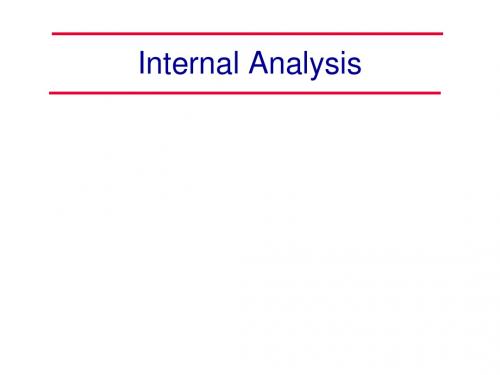
Support Activities
Inbound Logistics
HumaDevelopment Procurement Operations and Point Sale After Sales Service
Margin Profit Marketing or Loss
Distinctive Capabilities as a Consequence of Childhood Experiences
Company Capability Past History
Exxon
Financial management
Exxon’s predecessor, Standard Oil (NJ) was the holding co. for Rockefeller’s Standard Oil Trust Shell a j-v formed from Shell T&T founded to sell Russian oil in China, and Royal Dutch founded to exploit Indonesian reserves Discovered huge Persian reserves, went on to find Forties Field and Prudhoe Bay The Enrico Mattei legacy; the challenge of managing government relations in post-war Italy Vacuum Oil Co. founded in 1866 to supply 2 (Grant:2008) patented petroleum lubricants
IEC 60947-4-1 45.J1. (1 Pole with Shunt) 45.J4. (1
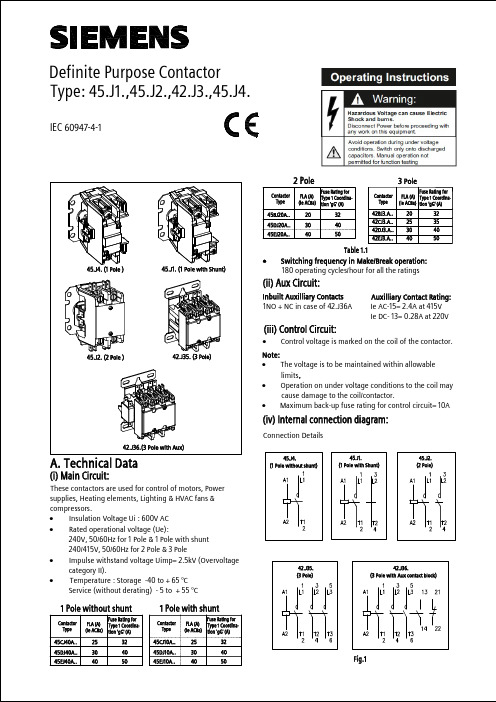
3 PoleContactor Type FLA (A) (Ie AC8a)Fuse Rating for Type 1 Coordina-tion 'gG' (A)Fuse Rating for Type 1 Coordina-tion 'gG' (A)DisposalSiemens product are environment friendly, which predominantly consist of recyclable materialsFor disposal we recommend disassembling and seperation into following materials:METALS: Segregate into Ferrous & Non Ferrous types for recycling through authorised dealer.PLASTICS: Segregate as per material type for recycling throughauthorised dealer. Because of the long lifetime of Siemens products the disposal guidelines may be replaced by other national regulations when taking the product out of service.The local customer care service is available at any time to answer disposal-related questions.Customer Care Toll free no. 1800 209 0987Email:ics.india@Order No. MISC4566_A Siemens Ltd.Product development is a continous process. Consequently the data indicated in this Leaflet is subject to change without prior notice.For latest issue contact our sales offices.Permissible Conductor Size: Termination Data of ContactorB. Installation1. Permitted mounting positions are indicated in Fig. 22. The unit is suitable for screw mounting on flat vertical surface with M5 screws applying 3 N-m torque. Always use plain and spring washers.Note: Install the unit in housing if it is a exposed to dust,dirt, contamination or aggressive atmosphere.C. Overall DimensionTerminal data 45.J1.45.J4.45.J2.45.J3.Main Terminals Screw Type Solid / Stranded2.5 to 10 Finely stranded with pin type lugs 2.5 to 10 Finely stranded with fork type lugs 2.5 to 25 AWG16-8*Main Terminals Box Type Solid / Stranded- - 2.5 to 25 Finely stranded with end sleeves - - 2.5 to 10 Finely stranded with pin type lugs - - 2.5 to 25 AWG cables - - 14-4 Main Terminals Quick connect Dual & Quad . 250" QC Dual . 250" QC Aux Terminals Quick connect Single. 250" QC Single . 250" QC Coil Terminals Quick connect Dual . 250" QCDual . 250" QCMain Terminals Screw SizePan, Hex screw M5 Box lug screwM8Tightening torqueScrew type(Lb.in / Nm)25 / 3 Tightening torqueBox type(Lb.in / Nm)40 / 4.5Fig.2360°22.5°22.5°Dimensional drawing:45.J1., 45.J4.45.J2.42.J3.* Stranding must be split for 8 AWG wire.Last update: 18 March 2021。
SCI-肾病杂志大全
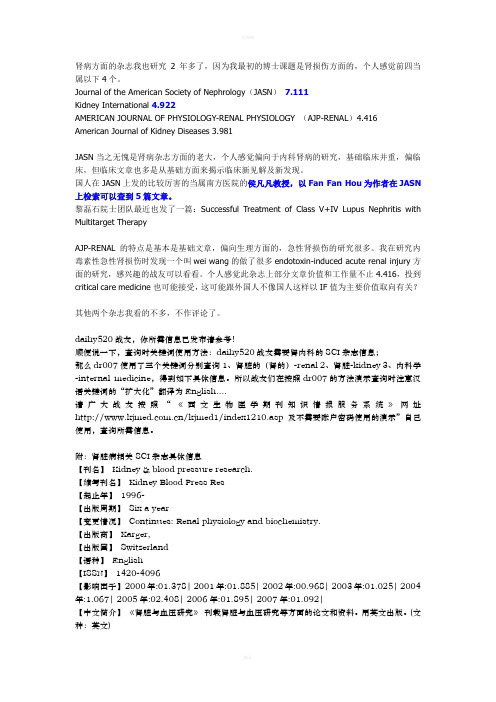
肾病方面的杂志我也研究2年多了,因为我最初的博士课题是肾损伤方面的,个人感觉前四当属以下4个。
Journal of the American Society of Nephrology(JASN)7.111Kidney International 4.922AMERICAN JOURNAL OF PHYSIOLOGY-RENAL PHYSIOLOGY (AJP-RENAL)4.416 American Journal of Kidney Diseases 3.981JASN当之无愧是肾病杂志方面的老大,个人感觉偏向于内科肾病的研究,基础临床并重,偏临床,但临床文章也多是从基础方面来揭示临床新见解及新发现。
国人在JASN上发的比较厉害的当属南方医院的侯凡凡教授,以Fan Fan Hou为作者在JASN 上检索可以查到5篇文章。
黎磊石院士团队最近也发了一篇:Successful Treatment of Class V+IV Lupus Nephritis with Multitarget TherapyAJP-RENAL的特点是基本是基础文章,偏向生理方面的,急性肾损伤的研究很多。
我在研究内毒素性急性肾损伤时发现一个叫wei wang的做了很多endotoxin-induced acute renal injury方面的研究,感兴趣的战友可以看看。
个人感觉此杂志上部分文章价值和工作量不止4.416,投到critical care medicine也可能接受,这可能跟外国人不像国人这样以IF值为主要价值取向有关?其他两个杂志我看的不多,不作评论了。
daihy520战友,你所需信息已发布请参考!顺便说一下,查询时关键词使用方法:daihy520战友需要肾内科的SCI杂志信息;那么dr007使用了三个关键词分别查询1、肾脏的(肾的)-renal 2、肾脏-kidney 3、内科学-internal medicine,得到如下具体信息。
- 1、下载文档前请自行甄别文档内容的完整性,平台不提供额外的编辑、内容补充、找答案等附加服务。
- 2、"仅部分预览"的文档,不可在线预览部分如存在完整性等问题,可反馈申请退款(可完整预览的文档不适用该条件!)。
- 3、如文档侵犯您的权益,请联系客服反馈,我们会尽快为您处理(人工客服工作时间:9:00-18:30)。
JInternalFrame的使用类层次结构图:--javax.swing.JComponent--javax.swing.JInternalFrameJinternalFrame的使用跟JFrame几乎一样,可以最大化、最小化、关闭窗口、加入菜单等功能;唯一不同的是JinternalFrame是lightweight component ,也就JInternalFrame不能单独出现,必须依附在最上层组件上。
由于这个特色,JInternalFrame能够利用java 提供的Look and Feel功能作出完全不同于原有操作系统所提供的窗口外型,也比JFrame更具有弹性。
一般我们会将Internal Fram加入Desktop Pane方便管理,Desktop Pane是一种特殊的Layered pane,用来建立虚拟桌面(Vitual Desktop).它可以显示并管理众多Internal Frame之间的层次关系。
以下是JDesktopPane的类层次结构图;类层次结构图:--javax.swing.JComponent--javax.swing.JLayeredPane--javax.swing.JDesktop我们先来看看如何构造JInternalFrame与JDesktopPane,再来看它跟Desktop Pane之间的关系。
下面分别是JInternalFram与JDesktopPane的构造函数:JInternalFrame构造函数:JInternalFrame():建立一个不能更改大小、不可关闭、不可最大最小化、也没有标题的Internal Frame。
JInternalFrame(String title):建立一个不能更改大小、不可关闭、不可最大最小化、但具有标题的Internal Frame。
JInternalFrame(String title,boolean resizable):建立一个不可关闭、不可最大最小化、但可变更大小且具有标题的 Internal Frame。
JInternalFrame(String title,boolean resizable,boolean closable):建立一个可关闭、可更改大小、且具有标题,但不可最大化最小化的Internal Frame.JInternalFrame(String title,boolean resizable,boolean closable,boolean maximizable):建立一个可关闭、可更改大小、具有标题、可最大化,但不可最小化的Internal Frame.JInternalFrame(String title,boolean resizable,boolean closable,boolean maximizable,boolean iconifiable):建立一个可关闭、可更改大小、具有标题、可最大化与最小化的Internal Frame.JDesktopPane构造函数:JDesktopPane():建立JDesktopPane组件。
如何利用JDesktoPane来管理JInternalFrame:JInternalFrame1.javaimport javax.swing.*;import java.awt.event.*;import java.awt.*;public class JInternalFrame1 extends JFrame implements ActionListener{JDesktopPane desktopPane;int count = 1;public JInternalFrame1() {super("JInternalFrame1");Container contentPane = this.getContentPane();contentPane.setLayout(new BorderLayout());JButton b = new JButton("Create New Internal Frames");b.addActionListener(this);//当用户按下按钮时,将运行actionPerformed()中的程序contentPane.add(b, BorderLayout.SOUTH);/*建立一个新的JDesktopPane并加入于contentPane中*/desktopPane = new JDesktopPane();contentPane.add(desktopPane);setSize(350, 350);show();addWindowListener(new WindowAdapter() {public void windowClosing(WindowEvent e) {System.exit(0);}});}/*产生一个可关闭、可改变大小、具有标题、可最大化与最小化的Internal Frame.*/public void actionPerformed(ActionEvent e){JInternalFrame internalFrame = new JInternalFrame( "Internal Frame "+(count++), true, true, true, true);internalFrame.setLocation( 20,20);internalFrame.setSize(200,200);internalFrame.setVisible(true);//取得JInternalFrame的Content Pane,用以加入新的组件。
Container icontentPane = internalFrame.getContentPane();JTextArea textArea = new JTextArea();JButton b = new JButton("Internal Frame Button");/*将JTextArea与JButton对象加入JInternalFrame中。
由此呆知,JInteranlFrame加入组件*的方式与JFrame是一模一样。
*/icontentPane.add(textArea,"Center");icontentPane.add(b,"South");//将JInternalFrame加入JDesktopPane中,如此一来,即使产生很多JInternalFrame,JDesktopPane也//能将它们之间的关系管理得相当良好。
desktopPane.add(internalFrame);try {internalFrame.setSelected(true);} catch (java.beans.PropertyVetoException ex) {System.out.println("Exception while selecting");}}public static void main(String[] args) {new JInternalFrame1();}}JPanel的使用:类层次结构图:--javax.swing.JComponent--javax.swing.JPanelPanel民是java中时常用到的容器之一,Panel除了可以让组件加入外,有效的利用Panel可以使版面管理更为容易。
Swing的JPanel支持double buffering的功能,使得JPanel在处理动画上更为流畅,较不会有画面闪烁的情况发生。
下面为它的构造函数:JPanel构造函数:JPanel():建立一个具有double buffering功能的JPanel,默认的版面管理是Flow Layout.JPanel(boolean isDoubleBuffered):选择建立是否具有double buffering功能的JPanel,默认的版面管理是Flow Layout.JPanel(LayoutManager layout):建立一个具有double buffering功能JPanel,可自定义版面管理器.JPanel(LayoutManager layout,boolean isDoubleBuffered):选择建立是否具有double buffering功能的JPanel,并自定义版面管理器.下面这个例子我们用JPanel来排列5个JLabel对象,你将可以发现利用JPanel搭配版面管理,可以做出更复杂的排列效果。
JPanel1.javaimport java.awt.*;import java.awt.event.*;import javax.swing.*;public class JPanel1{public JPanel1(){JFrame f = new JFrame("JPanelDemo");Container contentPane = f.getContentPane();contentPane.setLayout(new GridLayout(2,1));JLabel[] label = new JLabel[5];for(int i=0; i<label.length ; i++){label[i] = new JLabel("Label "+(i+1),JLabel.CENTER);label[i].setBackground(Color.lightGray);label[i].setBorder(BorderFactory.createEtchedBorder()); label[i].setOpaque(true);//setOpaqueIture)方法的目的是让组件变成不透明,这样我们在JLabel上所设置的颜色才能显示出来。
}JPanel panel1 = new JPanel(new GridLayout(1,1));panel1.add(label[0]);JPanel panel2 = new JPanel(new GridLayout(1,2));JPanel panel3 = new JPanel(new GridLayout(1,2));panel3.add(label[1]);panel3.add(label[2]);JPanel panel4 = new JPanel(new GridLayout(2,1));panel4.add(label[3]);panel4.add(label[4]);panel2.add(panel3);panel2.add(panel4);contentPane.add(panel1);contentPane.add(panel2);f.pack();f.show();f.addWindowListener(new WindowAdapter() {public void windowClosing(WindowEvent e) {System.exit(0);}});}public static void main(String[] arg){new JPanel1();}}由上例可知,利用JPanel可以使版面的排列方式更生动,若没有JPanel的帮助,想直接由contentPane排列成如上例所示,便必须借助复杂的GridBagLayout版面管理器了。
